de Sousa, Jose Moreira; Autreto, Pedro da Silva; Galvao, Douglas Soares
Hydrogenation Dynamics Process of Single-wall Carbon Nanotube Twisted (under review) Journal Article
In: 2019.
@article{deSousa2019d,
title = {Hydrogenation Dynamics Process of Single-wall Carbon Nanotube Twisted (under review)},
author = {de Sousa, Jose Moreira and Autreto, Pedro da Silva and Galvao, Douglas Soares},
year = {2019},
date = {2019-07-15},
keywords = {},
pubstate = {published},
tppubtype = {article}
}
Nakar, Dekel; Gordeev, Georgy; Machado, Leonardo D.; Popovitz-Biro, Ronit; Rechav, Katya; Oliveira, Eliezer F.; Kusch, Patryk; Jorio, Ado; Galvao, Douglas S.; Reich, Stephanie; Joselevich, Ernesto
Few-Wall Carbon Nanotube Coils (under review) Journal Article
In: 2019.
@article{Nakar2019,
title = {Few-Wall Carbon Nanotube Coils (under review)},
author = {Dekel Nakar and Georgy Gordeev and Leonardo D. Machado and Ronit Popovitz-Biro and Katya Rechav and Eliezer F. Oliveira and Patryk Kusch and Ado Jorio and Douglas S. Galvao and Stephanie Reich and Ernesto Joselevich},
year = {2019},
date = {2019-01-01},
keywords = {},
pubstate = {published},
tppubtype = {article}
}
Shadmi, Nitzan; Kremen, Anna; Frenkel, Yiftach; Lapin, Zachary J.; Machado, Leonardo D.; Legoas, Sergio B.; Bitton, Ora; Rechav, Katya; Popovitz-Biro, Ronit; Galvão, Douglas S.; Jorio, Ado; Novotny, Lukas; Kalisky, Beena; Joselevich, Ernesto
Defect-Free Carbon Nanotube Coils Online
2018, (reprint Nano Letters v16, 2152 (2016)).
@online{Shadmi2018,
title = {Defect-Free Carbon Nanotube Coils },
author = {Nitzan Shadmi and Anna Kremen and Yiftach Frenkel and Zachary J. Lapin and Leonardo D. Machado and Sergio B. Legoas and Ora Bitton and Katya Rechav and Ronit Popovitz-Biro and Douglas S. Galvão and Ado Jorio and Lukas Novotny and Beena Kalisky and Ernesto Joselevich},
url = {https://arxiv.org/abs/1802.03715},
year = {2018},
date = {2018-02-13},
abstract = {Carbon nanotubes are promising building blocks for various nanoelectronic components. A
highly desirable geometry for such applications is a coil. However, coiled nanotube structures
reported so far were inherently defective or had no free ends accessible for contacting. Here we
demonstrate the spontaneous self-coiling of single-wall carbon nanotubes into defect-free coils
of up to more than 70 turns with identical diameter and chirality, and free ends. We characterize
the structure, formation mechanism and electrical properties of these coils by different
microscopies, molecular dynamics simulations, Raman spectroscopy, and electrical and magnetic
measurements. The coils are highly conductive, as expected for defect-free carbon nanotubes,
but adjacent nanotube segments in the coil are more highly coupled than in regular bundles of
single-wall carbon nanotubes, owing to their perfect crystal momentum matching, which enables
tunneling between the turns. Although this behavior does not yet enable the performance of these
nanotube coils as inductive devices, it does point a clear path for their realization. Hence, this
study represents a major step toward the production of many different nanotube coil devices,
including inductors, electromagnets, transformers and dynamos.},
note = {reprint Nano Letters v16, 2152 (2016)},
keywords = {},
pubstate = {published},
tppubtype = {online}
}
highly desirable geometry for such applications is a coil. However, coiled nanotube structures
reported so far were inherently defective or had no free ends accessible for contacting. Here we
demonstrate the spontaneous self-coiling of single-wall carbon nanotubes into defect-free coils
of up to more than 70 turns with identical diameter and chirality, and free ends. We characterize
the structure, formation mechanism and electrical properties of these coils by different
microscopies, molecular dynamics simulations, Raman spectroscopy, and electrical and magnetic
measurements. The coils are highly conductive, as expected for defect-free carbon nanotubes,
but adjacent nanotube segments in the coil are more highly coupled than in regular bundles of
single-wall carbon nanotubes, owing to their perfect crystal momentum matching, which enables
tunneling between the turns. Although this behavior does not yet enable the performance of these
nanotube coils as inductive devices, it does point a clear path for their realization. Hence, this
study represents a major step toward the production of many different nanotube coil devices,
including inductors, electromagnets, transformers and dynamos.
Leonardo D Machado Sehmus Ozden, ChandraSekhar Tiwary
Ballistic Fracturing of Carbon Nanotubes Journal Article
In: ACS Applied Materials & Interfaces, vol. 8, no. 37, pp. 24819-24825, 2016.
@article{Ozden2016b,
title = {Ballistic Fracturing of Carbon Nanotubes},
author = {Sehmus Ozden, Leonardo D Machado, ChandraSekhar Tiwary, Pedro AS Autreto, Robert Vajtai, Enrique V Barrera, Douglas S Galvao, Pulickel M Ajayan},
url = {pubs.acs.org/doi/abs/10.1021/acsami.6b07547},
doi = {10.1021/acsami.6b07547},
year = {2016},
date = {2016-09-08},
journal = {ACS Applied Materials & Interfaces},
volume = {8},
number = {37},
pages = {24819-24825},
abstract = {Advanced materials with multifunctional capabilities and high resistance to hypervelocity impact are of great interest to the designers of aerospace structures. Carbon nanotubes (CNTs) with their lightweight and high strength properties are alternative to metals and/or metallic alloys conventionally used in aerospace applications. Here we report a detailed study on the ballistic fracturing of CNTs for different velocity ranges. Our results show that the highly energetic impacts cause bond breakage and carbon atom rehybridizations, and sometimes extensive structural reconstructions were also observed. Experimental observations show the formation of nanoribbons, nanodiamonds, and covalently interconnected nanostructures, depending on impact conditions. Fully atomistic reactive molecular dynamics simulations were also carried out in order to gain further insights into the mechanism behind the transformation of CNTs. The simulations show that the velocity and relative orientation of the multiple colliding nanotubes are critical to determine the impact outcome.},
keywords = {},
pubstate = {published},
tppubtype = {article}
}
Chandra Sekhar Tiwary Mohamad A Kabbani, Anirban Som
A generic approach for mechano-chemical reactions between carbon nanotubes of different functionalities Journal Article
In: Carbon, vol. 104, pp. 196-202, 2016.
@article{Kabbani2016,
title = {A generic approach for mechano-chemical reactions between carbon nanotubes of different functionalities},
author = {Mohamad A Kabbani, Chandra Sekhar Tiwary, Anirban Som, KR Krishnadas, Pedro AS Autreto, Sehmus Ozden, Kunttal Keyshar, Ken Hackenberg, Alin Christian Chipara, Douglas S Galvao, Robert Vajtai, Ahmad T Kabbani, Thalappil Pradeep, Pulickel M Ajayan},
url = {www.sciencedirect.com/science/article/pii/S000862231630183X},
doi = {10.1016/j.carbon.2016.02.094},
year = {2016},
date = {2016-08-31},
journal = {Carbon},
volume = {104},
pages = {196-202},
abstract = {Abstract Here, we report similar reactions between nanotubes carrying functionalities,
namely carbon nanotubes (CNTs) with the acyl chloride/hydroxyl and amine/carboxylic
functionalities directly attached to their surfaces, resulting in the formation ofchemically
modified graphene products. The reaction is spontaneous and is facilitated by simple
grinding of the reactants. The new solid-state reactions have been confirmed using different
spectroscopic and electron microscopy techniques.},
keywords = {},
pubstate = {published},
tppubtype = {article}
}
namely carbon nanotubes (CNTs) with the acyl chloride/hydroxyl and amine/carboxylic
functionalities directly attached to their surfaces, resulting in the formation ofchemically
modified graphene products. The reaction is spontaneous and is facilitated by simple
grinding of the reactants. The new solid-state reactions have been confirmed using different
spectroscopic and electron microscopy techniques.
Chandra Sekhar Tiwary Soumya Vinod, Leonardo D Machado
Synthesis of ultralow density 3D graphene–CNT foams using a two-step method Journal Article
In: Nanoscale, vol. 8, no. 35, pp. 15857-15863, 2016.
@article{Vinod2016b,
title = {Synthesis of ultralow density 3D graphene–CNT foams using a two-step method},
author = {Soumya Vinod, Chandra Sekhar Tiwary, Leonardo D Machado, Sehmus Ozden, Robert Vajtai, Douglas S Galvao, Pulickel M Ajayan},
url = {xlink.rsc.org/?DOI=c6nr04252j},
doi = {10.1039/C6NR04252J},
year = {2016},
date = {2016-08-09},
journal = {Nanoscale},
volume = {8},
number = {35},
pages = {15857-15863},
abstract = {Here, we report a highly scalable two-step method to produce graphene foams with ordered carbon nanotube reinforcements. In our approach, we first used solution assembly methods to obtain graphene oxide foam. Next, we employed chemical vapor deposition to simultaneously grow carbon nanotubes and thermally reduce the 3D graphene oxide scaffold. The resulting structure presented increased stiffness, good mechanical stability and oil absorption properties. Molecular dynamics simulations were carried out to further elucidate failure mechanisms and to understand the enhancement of the mechanical properties. The simulations showed that mechanical failure is directly associated with bending of vertical reinforcements, and that, for similar length and contact area, much more stress is required to bend the corresponding reinforcements of carbon nanotubes, thus explaining the experimentally observed enhanced mechanical properties.
},
keywords = {},
pubstate = {published},
tppubtype = {article}
}
Shaoli Fang Jiangtao Di, Francisco A Moura
Strong, Twist‐Stable Carbon Nanotube Yarns and Muscles by Tension Annealing at Extreme Temperatures Journal Article
In: Advanced Materials, vol. 28, no. 31, pp. 6598-6605, 2016.
@article{Di2016,
title = {Strong, Twist‐Stable Carbon Nanotube Yarns and Muscles by Tension Annealing at Extreme Temperatures},
author = {Jiangtao Di, Shaoli Fang, Francisco A Moura, Douglas S Galvão, Julia Bykova, Ali Aliev, Mônica Jung de Andrade, Xavier Lepró, Na Li, Carter Haines, Raquel Ovalle‐Robles, Dong Qian, Ray H Baughman},
url = {onlinelibrary.wiley.com/doi/10.1002/adma.201600628/full},
doi = {10.1002/adma.201600628},
year = {2016},
date = {2016-08-01},
journal = {Advanced Materials},
volume = {28},
number = {31},
pages = {6598-6605},
abstract = {A high-speed incandescent tension annealing process (ITAP) is used to increase the modulus and strength of twist-spun carbon nanotube yarns by up to 12-fold and 2.6-fold, respectively, provide remarkable resistance to oxidation and powerful protonating acids, and freeze yarn untwist. This twist stability enables torsional artificial-muscle motors having improved performance and minimizes problematic untwist during weaving nanotube yarns.},
keywords = {},
pubstate = {published},
tppubtype = {article}
}
Gustavo Brunetto Sehmus Ozden, N. S. Karthiselva
Controlled 3D Carbon Nanotube Structures by Plasma Welding Journal Article
In: Advanced Materials Interfaces, vol. 2016, pp. 1500755, 2016.
@article{Ozden2016,
title = {Controlled 3D Carbon Nanotube Structures by Plasma Welding},
author = {Sehmus Ozden, Gustavo Brunetto, N. S. Karthiselva, Douglas S. Galvão, Ajit Roy, Srinivasa R. Bakshi, Chandra S. Tiwary, andPulickel M. Ajayan},
url = {http://onlinelibrary.wiley.com/doi/10.1002/admi.201500755/abstract?campaign=wolearlyview},
doi = {10.1002/admi.201500755},
year = {2016},
date = {2016-03-17},
journal = {Advanced Materials Interfaces},
volume = {2016},
pages = {1500755},
abstract = {3D interconnected carbon nanotubes (CNTs) are synthesized using an industrially scalable spark plasma technique. At high electric field and elevated temperature under sufficient stress the nanotubes are welded together to form a solid block. The detailed spectroscopic and microscopic analyses show successful welding of the CNTs and formation of interconnected networks. The mechanical characteristics of the 3D CNT block show a high stiffness and yield strength. A full atomistic molecular dynamics simulation elucidates the CNT welding mechanism.},
keywords = {},
pubstate = {published},
tppubtype = {article}
}
de Sousa, Jose M.; Autreto, Pedro A. S.; Galvao, Douglas S.
Hydrogenation Dynamics of Twisted Carbon Nanotubes Online
2015, (ArXiv preprint).
@online{deSousa2015,
title = {Hydrogenation Dynamics of Twisted Carbon Nanotubes},
author = {Jose M. de Sousa and Pedro A. S. Autreto and Douglas S. Galvao},
url = {http://arxiv.org/abs/1510.00265},
year = {2015},
date = {2015-10-01},
abstract = {Carbon Nanotubes (CNTs) are one of the most important materials in nanotechnology. In some of their technological applications (electromechanical oscillators and mechanical actuators for artificial muscles, for instance), it is necessary to subject them to large deformations. Although this frequently happens in air, there are only few studies about the interaction of deformed CNTs with the atmosphere and the dynamics of these processes has not yet been addressed. In this work, we have investigated, through fully atomistic reactive molecular dynamics simulations, the process of hydrogenation of highly twisted CNTs. Our results show that hydrogenation effective ratio is directly related to the tube twist angle values and can lead to twisted tube fractures with well defined patterns (unzip-like). Our results also show that these fracture processes can be exploited to controllably produce graphene nanoribbons.},
note = {ArXiv preprint},
keywords = {},
pubstate = {published},
tppubtype = {online}
}
Chandra Sekhar Tiwary Mohamad A Kabbani, Pedro AS Autreto
Ambient solid-state mechano-chemical reactions between functionalized carbon nanotubes Journal Article
In: Nature Communications, vol. 6, pp. 7291, 2015.
@article{Kabbani2015,
title = {Ambient solid-state mechano-chemical reactions between functionalized carbon nanotubes},
author = {Mohamad A Kabbani, Chandra Sekhar Tiwary, Pedro AS Autreto, Gustavo Brunetto, Anirban Som, KR Krishnadas, Sehmus Ozden, Ken P Hackenberg, Yongi Gong, Douglas S Galvao, Robert Vajtai, Ahmad T Kabbani, Thalappil Pradeep, Pulickel M Ajayan},
url = {http://www.nature.com/ncomms/2015/150615/ncomms8291/full/ncomms8291.html},
doi = {10.1038/ncomms8291},
year = {2015},
date = {2015-06-15},
journal = {Nature Communications},
volume = {6},
pages = {7291},
abstract = {Carbon nanotubes can be chemically modified by attaching various functionalities to their surfaces, although harsh chemical treatments can lead to their break-up into graphene nanostructures. On the other hand, direct coupling between functionalities bound on individual nanotubes could lead to, as yet unexplored, spontaneous chemical reactions. Here we report an ambient mechano-chemical reaction between two varieties of nanotubes, carrying predominantly carboxyl and hydroxyl functionalities, respectively, facilitated by simple mechanical grinding of the reactants. The purely solid-state reaction between the chemically differentiated nanotube species produces condensation products and unzipping of nanotubes due to local energy release, as confirmed by spectroscopic measurements, thermal analysis and molecular dynamic simulations.},
keywords = {},
pubstate = {published},
tppubtype = {article}
}
Acrísio L Aguiar Nadia Ferreira Andrade, Yoong Ahm Kim
Linear Carbon Chains Under High Pressure Conditions Journal Article
In: The Journal of Physical Chemistry C, vol. 119, no. 19, pp. 10669–10676, 2015.
@article{Andrade2015,
title = {Linear Carbon Chains Under High Pressure Conditions},
author = {Nadia Ferreira Andrade, Acrísio L Aguiar, Yoong Ahm Kim, Morinobu Endo, Paulo TC Freire, Gustavo Bruneto, Douglas Soares Galvao, Mildred S Dresselhaus, Antonio Gomes Souza Filho},
url = {http://pubs.acs.org/doi/abs/10.1021/acs.jpcc.5b00902},
doi = {10.1021/acs.jpcc.5b00902},
year = {2015},
date = {2015-04-23},
journal = {The Journal of Physical Chemistry C},
volume = {119},
number = {19},
pages = {10669–10676},
abstract = {A high-pressure resonance Raman spectroscopy study of linear carbon chains encapsulated inside multiwalled carbon nanotubes (MWCNTs) is reported. While the frequencies of the tangential modes of carbon nanotubes (G band) harden as the pressure increases, the vibrational frequencies of the chain modes (around 1850 cm–1) decrease, thus indicating a softening of the carbon–carbon bonds in this 1D solid. Pressure-induced irreversible structural changes in the linear carbon chains are unveiled by the red shift in the vibrational modes when pressure is released. These results have been interpreted as being due to a coalescence of carbon chains, and this hypothesis is supported by state-of-the-art atomistic reactive molecular dynamics simulations.},
keywords = {},
pubstate = {published},
tppubtype = {article}
}
Ozden, Sehmus; Autreto, Pedro AS; Tiwary, Chandra Sekhar; Khatiwada, Suman; Machado, Leonardo; Galvao, Douglas S; Vajtai, Robert; Barrera, Enrique V; M. Ajayan, Pulickel
Unzipping Carbon Nanotubes at High Impact Journal Article
In: Nano letters, vol. 14, no. 7, pp. 4131–4137, 2014.
@article{ozden2014unzipping,
title = {Unzipping Carbon Nanotubes at High Impact},
author = {Ozden, Sehmus and Autreto, Pedro AS and Tiwary, Chandra Sekhar and Khatiwada, Suman and Machado, Leonardo and Galvao, Douglas S and Vajtai, Robert and Barrera, Enrique V and M. Ajayan, Pulickel},
url = {http://pubs.acs.org/doi/abs/10.1021/nl501753n},
year = {2014},
date = {2014-01-01},
journal = {Nano letters},
volume = {14},
number = {7},
pages = {4131--4137},
publisher = {American Chemical Society},
abstract = {The way nanostructures behave and mechanically respond to high impact collision is a topic of intrigue. For anisotropic nanostructures, such as carbon nanotubes, this response will be complicated based on the impact geometry. Here we report the result of hypervelocity impact of nanotubes against solid targets and show that impact produces a large number of defects in the nanotubes, as well as rapid atom evaporation, leading to their unzipping along the nanotube axis. Fully atomistic reactive molecular dynamics simulations are used to gain further insights of the pathways and deformation and fracture mechanisms of nanotubes under high energy mechanical impact. Carbon nanotubes have been unzipped into graphene nanoribbons before using chemical treatments but here the instability of nanotubes against defect formation, fracture, and unzipping is revealed purely through mechanical impact.},
keywords = {},
pubstate = {published},
tppubtype = {article}
}
Brunetto, Gustavo; Andrade, Nadia F.; Galvao, Douglas S; Antonio Filho, G Souza
High Pressure Induced Binding Between Linear Carbon Chains and Nanotubes Proceedings
2014.
@proceedings{brunetto2014high,
title = {High Pressure Induced Binding Between Linear Carbon Chains and Nanotubes},
author = {Brunetto, Gustavo and Andrade, Nadia F. and Galvao, Douglas S and Antonio Filho, G Souza},
url = {http://arxiv.org/abs/1412.7966},
year = {2014},
date = {2014-01-01},
journal = {arXiv preprint arXiv:1412.7966},
abstract = {Recent studies of single-walled carbon nanotubes (CNTs) in aqueous media have showed that water can significantly affect the tube mechanical properties. CNTs under hydrostatic compression can preserve their elastic properties up to large pressure values, while exhibiting exceptional resistance to mechanical loadings. It was experimentally observed that CNTs with encapsulated linear carbon chains (LCCs), when subjected to high hydrostatic pressure values, present irreversible red shifts in some of their vibrational frequencies. In order to address the cause of this phenomenon, we have carried out fully atomistic reactive (ReaxFF) molecular dynamics (MD) simulations for model structures mimicking the experimental conditions. We have considered the cases of finite and infinite (cyclic boundary conditions) CNTs filled with LCCs (LCC inside CNTs) of different lengths (from 9 up to 40 atoms). Our results show that increasing the hydrostatic pressure causes the CNT to be deformed in an inhomogeneous way due to the LCC presence. The LCC-CNT interface regions exhibit convex curvatures, which results in more reactive sites, thus favoring the formation of covalent chemical bonds between the chain and the nanotube. This process is irreversible with the newly formed bonds continuing to exist even after releasing the external pressure and causing an irreversibly red shift in the chain vibrational modes from 1850 to 1500 cm−1.},
keywords = {},
pubstate = {published},
tppubtype = {proceedings}
}
SB Legoas LD Machado, JS Soares
Dynamics of the formation of carbon nanotube serpentines Journal Article
In: Physical Review Letters, vol. 110, no. 10, pp. 105502, 2013.
@article{machado2013dynamics,
title = {Dynamics of the formation of carbon nanotube serpentines},
author = {LD Machado, SB Legoas, JS Soares, N Shadmi, A Jorio, E Joselevich, DS Galvão},
url = {http://journals.aps.org/prl/abstract/10.1103/PhysRevLett.110.105502},
year = {2013},
date = {2013-01-01},
journal = {Physical Review Letters},
volume = {110},
number = {10},
pages = {105502},
publisher = {American Physical Society},
abstract = {Recently, Geblinger et al. [Nat. Nanotechnol. 3, 195 (2008)] reported the experimental realization of carbon nanotube S-like shaped nanostructures, the so-called carbon nanotube serpentines. We report here results from multimillion fully atomistic molecular dynamics simulations of their formation. We consider one-μm-long carbon nanotubes placed on stepped substrates with and without a catalyst nanoparticle on the top free end of the tube. A force is applied to the upper part of the tube during a short period of time and turned off; then the system is set free to evolve in time. Our results show that these conditions are sufficient to form robust serpentines and validates the general features of the “falling spaghetti model” proposed to explain their formation.
},
keywords = {},
pubstate = {published},
tppubtype = {article}
}
Perim, Eric; Paupitz, Ricardo; Galvao, Douglas S
Controlled route to the fabrication of carbon and boron nitride nanoscrolls: A molecular dynamics investigation Journal Article
In: Journal of Applied Physics, vol. 113, no. 5, pp. 054306, 2013.
@article{perim2013controlled,
title = {Controlled route to the fabrication of carbon and boron nitride nanoscrolls: A molecular dynamics investigation},
author = {Perim, Eric and Paupitz, Ricardo and Galvao, Douglas S},
url = {http://scitation.aip.org/content/aip/journal/jap/113/5/10.1063/1.4790304},
year = {2013},
date = {2013-01-01},
journal = {Journal of Applied Physics},
volume = {113},
number = {5},
pages = {054306},
publisher = {AIP Publishing},
abstract = {Carbon nanoscrolls (graphene layers rolled up into papyrus-like tubular structures) are nanostructures with unique and interesting characteristics that could be exploited to build several new nanodevices. However, an efficient and controlled synthesis of these structures was not achieved yet, making its large scale production a challenge to materials scientists. Also, the formation process and detailed mechanisms that occur during its synthesis are not completely known. In this work, using fully atomistic molecular dynamics simulations, we discuss a possible route to nanoscrolls made from graphene layers deposited over silicon oxide substrates containing chambers/pits. The scrolling mechanism is triggered by carbon nanotubes deposited on the layers. The process is completely general and can be used to produce scrolls from other lamellar materials, like boron nitride, for instance.},
keywords = {},
pubstate = {published},
tppubtype = {article}
}
Lima, Marcio D; Li, Na; De Andrade, Monica Jung; Fang, Shaoli; Oh, Jiyoung; Spinks, Geoffrey M; Kozlov, Mikhail E; Haines, Carter S; Suh, Dongseok; Foroughi, Javad; Kim, Seon Jeong; Chen, Yongsheng; Ware, Taylor; Shin, Min Kyoon; Machado, Leonardo D; Fonseca, Alexandre F; Madden, John DW; Voit, Walter E; Galvao, Douglas S; Baughman, Ray H
Electrically, chemically, and photonically powered torsional and tensile actuation of hybrid carbon nanotube yarn muscles Journal Article
In: Science, vol. 338, no. 6109, pp. 928–932, 2012.
@article{lima2012electrically,
title = {Electrically, chemically, and photonically powered torsional and tensile actuation of hybrid carbon nanotube yarn muscles},
author = {Lima, Marcio D and Li, Na and De Andrade, Monica Jung and Fang, Shaoli and Oh, Jiyoung and Spinks, Geoffrey M and Kozlov, Mikhail E and Haines, Carter S and Suh, Dongseok and Foroughi, Javad and Kim, Seon Jeong and Chen, Yongsheng and Ware, Taylor and Shin, Min Kyoon and Machado, Leonardo D and Fonseca, Alexandre F and Madden, John DW and Voit, Walter E and Galvao, Douglas S and Baughman, Ray H
},
url = {http://www.sciencemag.org/content/338/6109/928.short},
year = {2012},
date = {2012-01-01},
journal = {Science},
volume = {338},
number = {6109},
pages = {928--932},
publisher = {American Association for the Advancement of Science},
abstract = {Artificial muscles are of practical interest, but few types have been commercially exploited. Typical problems include slow response, low strain and force generation, short cycle life, use of electrolytes, and low energy efficiency. We have designed guest-filled, twist-spun carbon nanotube yarns as electrolyte-free muscles that provide fast, high-force, large-stroke torsional and tensile actuation. More than a million torsional and tensile actuation cycles are demonstrated, wherein a muscle spins a rotor at an average 11,500 revolutions/minute or delivers 3% tensile contraction at 1200 cycles/minute. Electrical, chemical, or photonic excitation of hybrid yarns changes guest dimensions and generates torsional rotation and contraction of the yarn host. Demonstrations include torsional motors, contractile muscles, and sensors that capture the energy of the sensing process to mechanically actuate.},
keywords = {},
pubstate = {published},
tppubtype = {article}
}
Machado, Leonardo D; Legoas, Sergio B; Galvao, Douglas S
Multi-Million Fully Atomistic Molecular Dynamics Simulations of Yarn Formation from Carbon Nanotube Forests Proceedings
Cambridge University Press, vol. 1407, 2012.
@proceedings{machado2012multi,
title = {Multi-Million Fully Atomistic Molecular Dynamics Simulations of Yarn Formation from Carbon Nanotube Forests},
author = {Machado, Leonardo D and Legoas, Sergio B and Galvao, Douglas S},
url = {http://journals.cambridge.org/action/displayAbstract?fromPage=online&aid=8537115&fulltextType=RA&fileId=S1946427412007105},
year = {2012},
date = {2012-01-01},
journal = {MRS Proceedings},
volume = {1407},
pages = {mrsf11--1407},
publisher = {Cambridge University Press},
abstract = {In this work we present preliminary results from multi-million fully atomistic classical molecular dynamics simulations carried out to test different existing mechanisms that have been proposed in the literature to explain the drawing of yarns from carbon nanotube forests. Despite the fact that it has been almost ten years since yarns were first drawn, there are still controversies on the mechanisms and necessary conditions that can produce yarns and sheets drawn from carbon nanotube forests. Moreover, few works have tried to understand at atomistic level the details of yarn drawing mechanisms, and no fully atomistic simulations have been carried out so far on this particular subject. Our preliminary results suggest that only direct van der Waals interactions among large bundles seem not to be enough to explain the yarn drawing process. Bundle interconnectors (such as small bundles connecting large bundles) were observed to play a critical role in our simulations. Depending on the topology of these interconnectors it was possible to observe from the simulations fibers/yarn formation from proposed structural models. These models were built based on structural information inferred from scanning electron microscopy data.},
keywords = {},
pubstate = {published},
tppubtype = {proceedings}
}
Legoas, SB; dos Santos, RPB; Troche, KS; Coluci, VR; Galvao, Douglas S
On the Existence of Ordered Phases of Encapsulated Diamondoids into Carbon Nanotubes Proceedings
Cambridge University Press, vol. 1407, 2012.
@proceedings{legoas2012existence,
title = {On the Existence of Ordered Phases of Encapsulated Diamondoids into Carbon Nanotubes},
author = {Legoas, SB and dos Santos, RPB and Troche, KS and Coluci, VR and Galvao, Douglas S},
url = {http://journals.cambridge.org/action/displayAbstract?fromPage=online&aid=8539583&fileId=S194642741200704X},
year = {2012},
date = {2012-01-01},
journal = {MRS Proceedings},
volume = {1407},
pages = {mrsf11--1407},
publisher = {Cambridge University Press},
abstract = {We have investigated some diamondoids encapsulation into single walled carbon nanotubes (with diameters ranging from1.0 up to 2.2 nm) using fully atomistic molecular dynamics simulations. Diamondoids are the smallest hydrogen-terminated nanosized diamond-like molecules. Diamondois have been investigated for a large class of applications, ranging from oil industry to pharmaceuticals. Molecular ordered phases were observed for the encapsulation of adamantane, diamantane, and dihydroxy diamantanes. Chiral ordered phases, such as; double, triple, 4- and 5-stranded helices were also observed for those diamondoids. Our results also indicate that the modification of diamondoids through chemical functionalization with hydroxyl groups can lead to an enhancement of the molecular packing inside the carbon nanotubes in comparison to non-functionalized molecules. For larger diamondoids (such as, adamantane tetramers), we have not observed long-range ordering, but only a tendency of incomplete helical structural formation.},
keywords = {},
pubstate = {published},
tppubtype = {proceedings}
}
dos Santos, Ricardo P; Autreto, Pedro A; Perim, Eric; Brunetto, Gustavo; Galvao, Douglas S
On the Unzipping Mechanisms of Carbon Nanotubes: Insights from Reactive Molecular Dynamics Simulations Proceedings
Cambridge University Press, vol. 1451, 2012.
@proceedings{dos2012unzipping,
title = {On the Unzipping Mechanisms of Carbon Nanotubes: Insights from Reactive Molecular Dynamics Simulations},
author = {dos Santos, Ricardo P and Autreto, Pedro A and Perim, Eric and Brunetto, Gustavo and Galvao, Douglas S},
url = {http://journals.cambridge.org/action/displayAbstract?fromPage=online&aid=8652294&fileId=S1946427412013292},
year = {2012},
date = {2012-01-01},
journal = {MRS Proceedings},
volume = {1451},
pages = {3--8},
publisher = {Cambridge University Press},
abstract = {Unzipping carbon nanotubes (CNTs) is considered one of the most promising approaches for the controlled and large-scale production of graphene nanoribbons (GNR). These structures are considered of great importance for the development of nanoelectronics because of its dimensions and intrinsic nonzero band gap value. Despite many years of investigations some details on the dynamics of the CNT fracture/unzipping processes remain unclear. In this work we have investigated some of these process through molecular dynamics simulations using reactive force fields (ReaxFF), as implemented in the Large-scale Atomic/Molecular Massively Parallel Simulator (LAMMPS) code. We considered multi-walled CNTs of different dimensions and chiralities and under induced mechanical stretching. Our preliminary results show that the unzipping mechanisms are highly dependent on CNT chirality. Well-defined and distinct fracture patterns were observed for the different chiralities. Armchair CNTs favor the creation of GNRs with well-defined armchair edges, while zigzag and chiral ones produce GNRs with less defined and defective edges.},
keywords = {},
pubstate = {published},
tppubtype = {proceedings}
}
Dos Santos, RPB; Perim, E; Autreto, PAS; Brunetto, Gustavo; Galvao, DS
On the unzipping of multiwalled carbon nanotubes Journal Article
In: Nanotechnology, vol. 23, no. 46, pp. 465702, 2012.
@article{dos2012unzippingb,
title = {On the unzipping of multiwalled carbon nanotubes},
author = {Dos Santos, RPB and Perim, E and Autreto, PAS and Brunetto, Gustavo and Galvao, DS},
url = {http://iopscience.iop.org/0957-4484/23/46/465702},
year = {2012},
date = {2012-01-01},
journal = {Nanotechnology},
volume = {23},
number = {46},
pages = {465702},
publisher = {IOP Publishing},
abstract = {Graphene nanoribbons (GNRs) are very interesting structures which can retain graphene's high carrier mobility while presenting a finite bandgap. These properties make GNRs very valuable materials for the building of nanodevices. Unzipping carbon nanotubes (CNTs) is considered one of the most promising approaches for GNR controlled and large-scale production, although some of the details of the CNT unzipping processes are not completely known. In this work we have investigated CNT unzipping processes through fully atomistic molecular dynamics simulations using reactive force fields (ReaxFF). Multiwalled CNTs of different dimensions and chiralities under induced mechanical stretching were considered. Our results show that fracture patterns and stress profiles are highly CNT chirality dependent. Our results also show that the 'crests' (partially unzipped CNT regions presenting high curvature), originating from defective CNT areas, can act as a guide for the unzipping processes, which can explain the almost perfectly linear cuts frequently observed in unzipped CNTs.
},
keywords = {},
pubstate = {published},
tppubtype = {article}
}
2019
de Sousa, Jose Moreira; Autreto, Pedro da Silva; Galvao, Douglas Soares
Hydrogenation Dynamics Process of Single-wall Carbon Nanotube Twisted (under review) Journal Article
In: 2019.
BibTeX | Tags: Carbon Nanotubes, Hydrogenation, Mechanical Properties, Molecular Dynamics
@article{deSousa2019d,
title = {Hydrogenation Dynamics Process of Single-wall Carbon Nanotube Twisted (under review)},
author = {de Sousa, Jose Moreira and Autreto, Pedro da Silva and Galvao, Douglas Soares},
year = {2019},
date = {2019-07-15},
keywords = {Carbon Nanotubes, Hydrogenation, Mechanical Properties, Molecular Dynamics},
pubstate = {published},
tppubtype = {article}
}
Nakar, Dekel; Gordeev, Georgy; Machado, Leonardo D.; Popovitz-Biro, Ronit; Rechav, Katya; Oliveira, Eliezer F.; Kusch, Patryk; Jorio, Ado; Galvao, Douglas S.; Reich, Stephanie; Joselevich, Ernesto
Few-Wall Carbon Nanotube Coils (under review) Journal Article
In: 2019.
BibTeX | Tags: Carbon Nanotubes, Molecular Dynamics, Nanocoils, Raman
@article{Nakar2019,
title = {Few-Wall Carbon Nanotube Coils (under review)},
author = {Dekel Nakar and Georgy Gordeev and Leonardo D. Machado and Ronit Popovitz-Biro and Katya Rechav and Eliezer F. Oliveira and Patryk Kusch and Ado Jorio and Douglas S. Galvao and Stephanie Reich and Ernesto Joselevich},
year = {2019},
date = {2019-01-01},
keywords = {Carbon Nanotubes, Molecular Dynamics, Nanocoils, Raman},
pubstate = {published},
tppubtype = {article}
}
2018
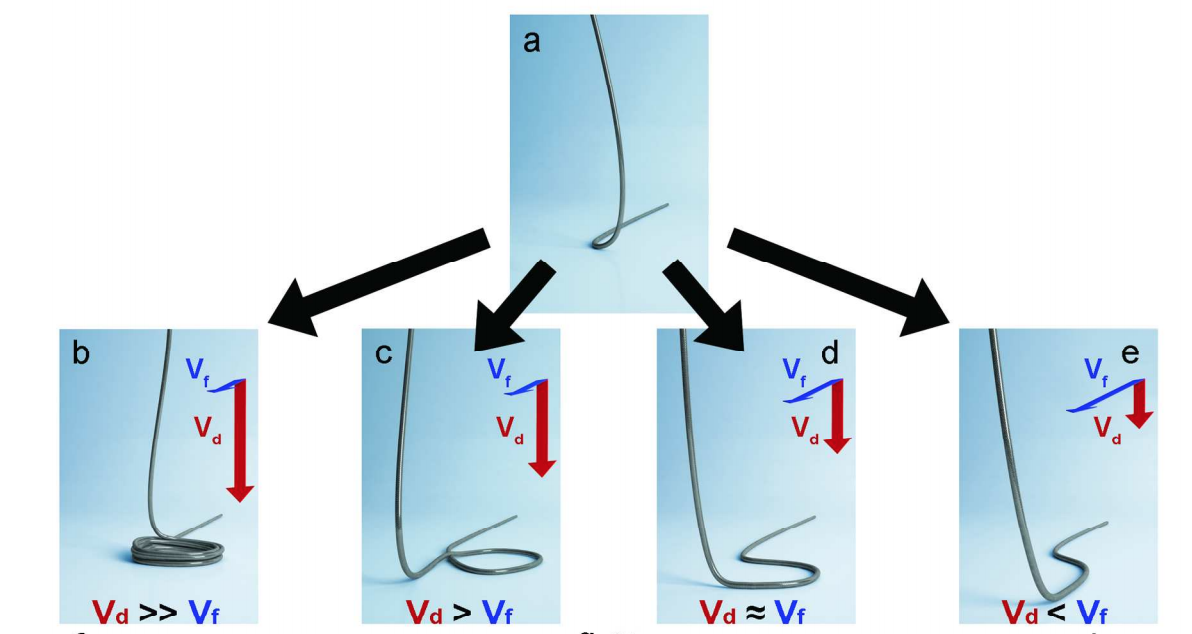
Shadmi, Nitzan; Kremen, Anna; Frenkel, Yiftach; Lapin, Zachary J.; Machado, Leonardo D.; Legoas, Sergio B.; Bitton, Ora; Rechav, Katya; Popovitz-Biro, Ronit; Galvão, Douglas S.; Jorio, Ado; Novotny, Lukas; Kalisky, Beena; Joselevich, Ernesto
Defect-Free Carbon Nanotube Coils Online
2018, (reprint Nano Letters v16, 2152 (2016)).
Abstract | Links | BibTeX | Tags: Carbon Nanotubes, Modeling, Nanocoils
@online{Shadmi2018,
title = {Defect-Free Carbon Nanotube Coils },
author = {Nitzan Shadmi and Anna Kremen and Yiftach Frenkel and Zachary J. Lapin and Leonardo D. Machado and Sergio B. Legoas and Ora Bitton and Katya Rechav and Ronit Popovitz-Biro and Douglas S. Galvão and Ado Jorio and Lukas Novotny and Beena Kalisky and Ernesto Joselevich},
url = {https://arxiv.org/abs/1802.03715},
year = {2018},
date = {2018-02-13},
abstract = {Carbon nanotubes are promising building blocks for various nanoelectronic components. A
highly desirable geometry for such applications is a coil. However, coiled nanotube structures
reported so far were inherently defective or had no free ends accessible for contacting. Here we
demonstrate the spontaneous self-coiling of single-wall carbon nanotubes into defect-free coils
of up to more than 70 turns with identical diameter and chirality, and free ends. We characterize
the structure, formation mechanism and electrical properties of these coils by different
microscopies, molecular dynamics simulations, Raman spectroscopy, and electrical and magnetic
measurements. The coils are highly conductive, as expected for defect-free carbon nanotubes,
but adjacent nanotube segments in the coil are more highly coupled than in regular bundles of
single-wall carbon nanotubes, owing to their perfect crystal momentum matching, which enables
tunneling between the turns. Although this behavior does not yet enable the performance of these
nanotube coils as inductive devices, it does point a clear path for their realization. Hence, this
study represents a major step toward the production of many different nanotube coil devices,
including inductors, electromagnets, transformers and dynamos.},
note = {reprint Nano Letters v16, 2152 (2016)},
keywords = {Carbon Nanotubes, Modeling, Nanocoils},
pubstate = {published},
tppubtype = {online}
}
highly desirable geometry for such applications is a coil. However, coiled nanotube structures
reported so far were inherently defective or had no free ends accessible for contacting. Here we
demonstrate the spontaneous self-coiling of single-wall carbon nanotubes into defect-free coils
of up to more than 70 turns with identical diameter and chirality, and free ends. We characterize
the structure, formation mechanism and electrical properties of these coils by different
microscopies, molecular dynamics simulations, Raman spectroscopy, and electrical and magnetic
measurements. The coils are highly conductive, as expected for defect-free carbon nanotubes,
but adjacent nanotube segments in the coil are more highly coupled than in regular bundles of
single-wall carbon nanotubes, owing to their perfect crystal momentum matching, which enables
tunneling between the turns. Although this behavior does not yet enable the performance of these
nanotube coils as inductive devices, it does point a clear path for their realization. Hence, this
study represents a major step toward the production of many different nanotube coil devices,
including inductors, electromagnets, transformers and dynamos.
2016
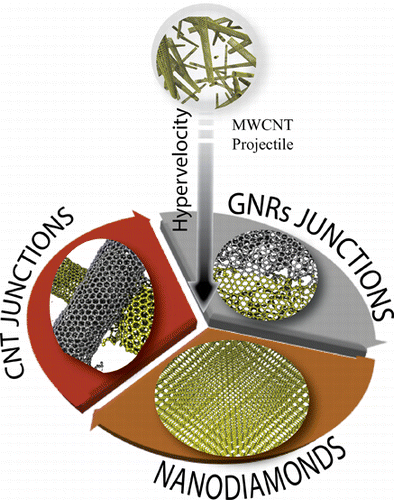
Leonardo D Machado Sehmus Ozden, ChandraSekhar Tiwary
Ballistic Fracturing of Carbon Nanotubes Journal Article
In: ACS Applied Materials & Interfaces, vol. 8, no. 37, pp. 24819-24825, 2016.
Abstract | Links | BibTeX | Tags: Ballistic Impact, Carbon Nanotubes, Molecular Dynamics
@article{Ozden2016b,
title = {Ballistic Fracturing of Carbon Nanotubes},
author = {Sehmus Ozden, Leonardo D Machado, ChandraSekhar Tiwary, Pedro AS Autreto, Robert Vajtai, Enrique V Barrera, Douglas S Galvao, Pulickel M Ajayan},
url = {pubs.acs.org/doi/abs/10.1021/acsami.6b07547},
doi = {10.1021/acsami.6b07547},
year = {2016},
date = {2016-09-08},
journal = {ACS Applied Materials & Interfaces},
volume = {8},
number = {37},
pages = {24819-24825},
abstract = {Advanced materials with multifunctional capabilities and high resistance to hypervelocity impact are of great interest to the designers of aerospace structures. Carbon nanotubes (CNTs) with their lightweight and high strength properties are alternative to metals and/or metallic alloys conventionally used in aerospace applications. Here we report a detailed study on the ballistic fracturing of CNTs for different velocity ranges. Our results show that the highly energetic impacts cause bond breakage and carbon atom rehybridizations, and sometimes extensive structural reconstructions were also observed. Experimental observations show the formation of nanoribbons, nanodiamonds, and covalently interconnected nanostructures, depending on impact conditions. Fully atomistic reactive molecular dynamics simulations were also carried out in order to gain further insights into the mechanism behind the transformation of CNTs. The simulations show that the velocity and relative orientation of the multiple colliding nanotubes are critical to determine the impact outcome.},
keywords = {Ballistic Impact, Carbon Nanotubes, Molecular Dynamics},
pubstate = {published},
tppubtype = {article}
}

Chandra Sekhar Tiwary Mohamad A Kabbani, Anirban Som
A generic approach for mechano-chemical reactions between carbon nanotubes of different functionalities Journal Article
In: Carbon, vol. 104, pp. 196-202, 2016.
Abstract | Links | BibTeX | Tags: Carbon Nanotubes, DFT, Fracture, Mechano-chemistry, Molecular Dynamics
@article{Kabbani2016,
title = {A generic approach for mechano-chemical reactions between carbon nanotubes of different functionalities},
author = {Mohamad A Kabbani, Chandra Sekhar Tiwary, Anirban Som, KR Krishnadas, Pedro AS Autreto, Sehmus Ozden, Kunttal Keyshar, Ken Hackenberg, Alin Christian Chipara, Douglas S Galvao, Robert Vajtai, Ahmad T Kabbani, Thalappil Pradeep, Pulickel M Ajayan},
url = {www.sciencedirect.com/science/article/pii/S000862231630183X},
doi = {10.1016/j.carbon.2016.02.094},
year = {2016},
date = {2016-08-31},
journal = {Carbon},
volume = {104},
pages = {196-202},
abstract = {Abstract Here, we report similar reactions between nanotubes carrying functionalities,
namely carbon nanotubes (CNTs) with the acyl chloride/hydroxyl and amine/carboxylic
functionalities directly attached to their surfaces, resulting in the formation ofchemically
modified graphene products. The reaction is spontaneous and is facilitated by simple
grinding of the reactants. The new solid-state reactions have been confirmed using different
spectroscopic and electron microscopy techniques.},
keywords = {Carbon Nanotubes, DFT, Fracture, Mechano-chemistry, Molecular Dynamics},
pubstate = {published},
tppubtype = {article}
}
namely carbon nanotubes (CNTs) with the acyl chloride/hydroxyl and amine/carboxylic
functionalities directly attached to their surfaces, resulting in the formation ofchemically
modified graphene products. The reaction is spontaneous and is facilitated by simple
grinding of the reactants. The new solid-state reactions have been confirmed using different
spectroscopic and electron microscopy techniques.
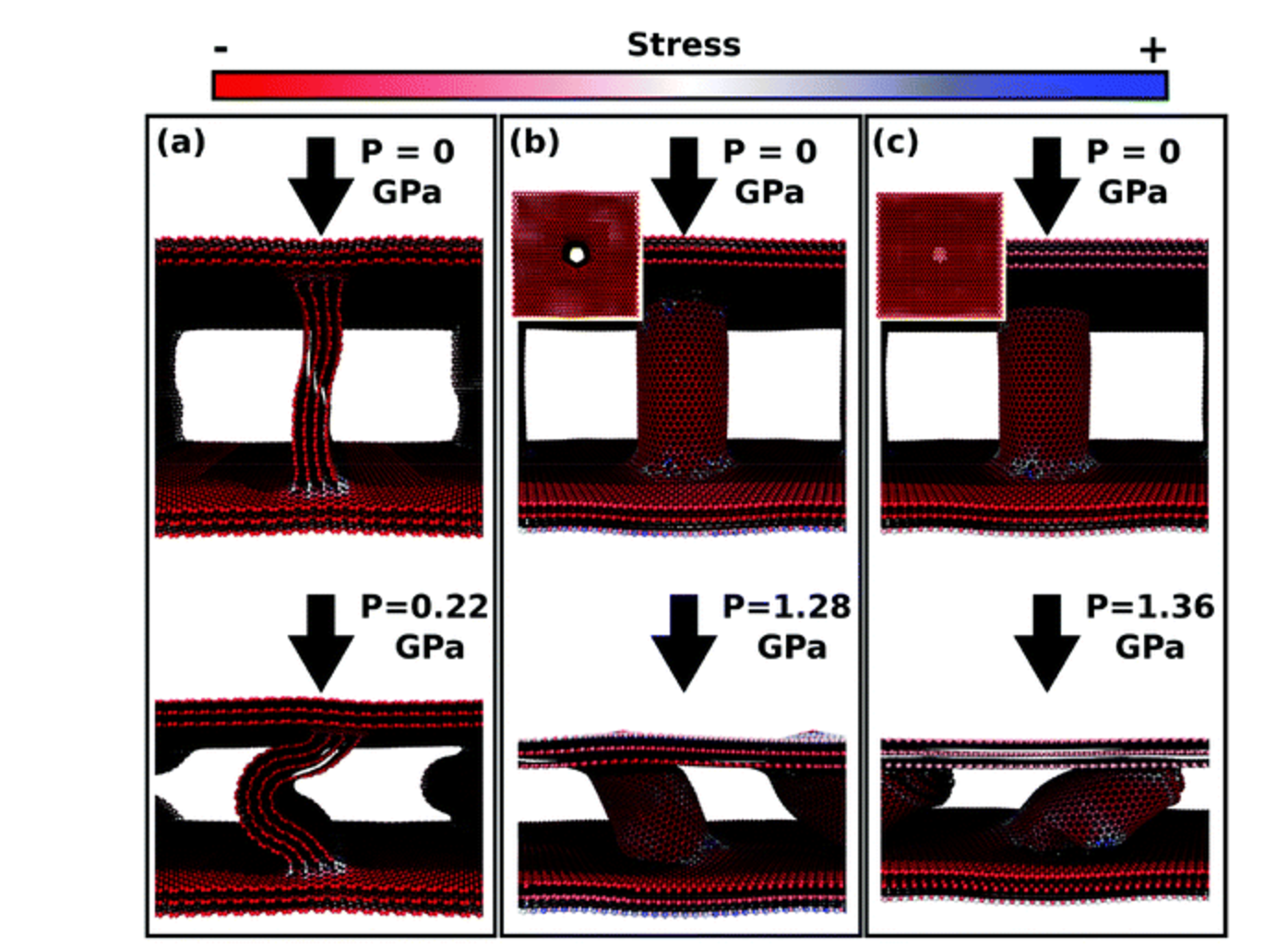
Chandra Sekhar Tiwary Soumya Vinod, Leonardo D Machado
Synthesis of ultralow density 3D graphene–CNT foams using a two-step method Journal Article
In: Nanoscale, vol. 8, no. 35, pp. 15857-15863, 2016.
Abstract | Links | BibTeX | Tags: Carbon Nanotubes, foams, Molecular Dynamics
@article{Vinod2016b,
title = {Synthesis of ultralow density 3D graphene–CNT foams using a two-step method},
author = {Soumya Vinod, Chandra Sekhar Tiwary, Leonardo D Machado, Sehmus Ozden, Robert Vajtai, Douglas S Galvao, Pulickel M Ajayan},
url = {xlink.rsc.org/?DOI=c6nr04252j},
doi = {10.1039/C6NR04252J},
year = {2016},
date = {2016-08-09},
journal = {Nanoscale},
volume = {8},
number = {35},
pages = {15857-15863},
abstract = {Here, we report a highly scalable two-step method to produce graphene foams with ordered carbon nanotube reinforcements. In our approach, we first used solution assembly methods to obtain graphene oxide foam. Next, we employed chemical vapor deposition to simultaneously grow carbon nanotubes and thermally reduce the 3D graphene oxide scaffold. The resulting structure presented increased stiffness, good mechanical stability and oil absorption properties. Molecular dynamics simulations were carried out to further elucidate failure mechanisms and to understand the enhancement of the mechanical properties. The simulations showed that mechanical failure is directly associated with bending of vertical reinforcements, and that, for similar length and contact area, much more stress is required to bend the corresponding reinforcements of carbon nanotubes, thus explaining the experimentally observed enhanced mechanical properties.
},
keywords = {Carbon Nanotubes, foams, Molecular Dynamics},
pubstate = {published},
tppubtype = {article}
}
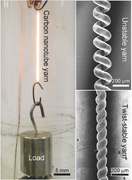
Shaoli Fang Jiangtao Di, Francisco A Moura
Strong, Twist‐Stable Carbon Nanotube Yarns and Muscles by Tension Annealing at Extreme Temperatures Journal Article
In: Advanced Materials, vol. 28, no. 31, pp. 6598-6605, 2016.
Abstract | Links | BibTeX | Tags: Artificial Muscles, Carbon Nanotubes, Modeling
@article{Di2016,
title = {Strong, Twist‐Stable Carbon Nanotube Yarns and Muscles by Tension Annealing at Extreme Temperatures},
author = {Jiangtao Di, Shaoli Fang, Francisco A Moura, Douglas S Galvão, Julia Bykova, Ali Aliev, Mônica Jung de Andrade, Xavier Lepró, Na Li, Carter Haines, Raquel Ovalle‐Robles, Dong Qian, Ray H Baughman},
url = {onlinelibrary.wiley.com/doi/10.1002/adma.201600628/full},
doi = {10.1002/adma.201600628},
year = {2016},
date = {2016-08-01},
journal = {Advanced Materials},
volume = {28},
number = {31},
pages = {6598-6605},
abstract = {A high-speed incandescent tension annealing process (ITAP) is used to increase the modulus and strength of twist-spun carbon nanotube yarns by up to 12-fold and 2.6-fold, respectively, provide remarkable resistance to oxidation and powerful protonating acids, and freeze yarn untwist. This twist stability enables torsional artificial-muscle motors having improved performance and minimizes problematic untwist during weaving nanotube yarns.},
keywords = {Artificial Muscles, Carbon Nanotubes, Modeling},
pubstate = {published},
tppubtype = {article}
}

Gustavo Brunetto Sehmus Ozden, N. S. Karthiselva
Controlled 3D Carbon Nanotube Structures by Plasma Welding Journal Article
In: Advanced Materials Interfaces, vol. 2016, pp. 1500755, 2016.
Abstract | Links | BibTeX | Tags: 3D networks, Carbon Nanotubes, Elasticity, Molecular Dynamics
@article{Ozden2016,
title = {Controlled 3D Carbon Nanotube Structures by Plasma Welding},
author = {Sehmus Ozden, Gustavo Brunetto, N. S. Karthiselva, Douglas S. Galvão, Ajit Roy, Srinivasa R. Bakshi, Chandra S. Tiwary, andPulickel M. Ajayan},
url = {http://onlinelibrary.wiley.com/doi/10.1002/admi.201500755/abstract?campaign=wolearlyview},
doi = {10.1002/admi.201500755},
year = {2016},
date = {2016-03-17},
journal = {Advanced Materials Interfaces},
volume = {2016},
pages = {1500755},
abstract = {3D interconnected carbon nanotubes (CNTs) are synthesized using an industrially scalable spark plasma technique. At high electric field and elevated temperature under sufficient stress the nanotubes are welded together to form a solid block. The detailed spectroscopic and microscopic analyses show successful welding of the CNTs and formation of interconnected networks. The mechanical characteristics of the 3D CNT block show a high stiffness and yield strength. A full atomistic molecular dynamics simulation elucidates the CNT welding mechanism.},
keywords = {3D networks, Carbon Nanotubes, Elasticity, Molecular Dynamics},
pubstate = {published},
tppubtype = {article}
}
2015
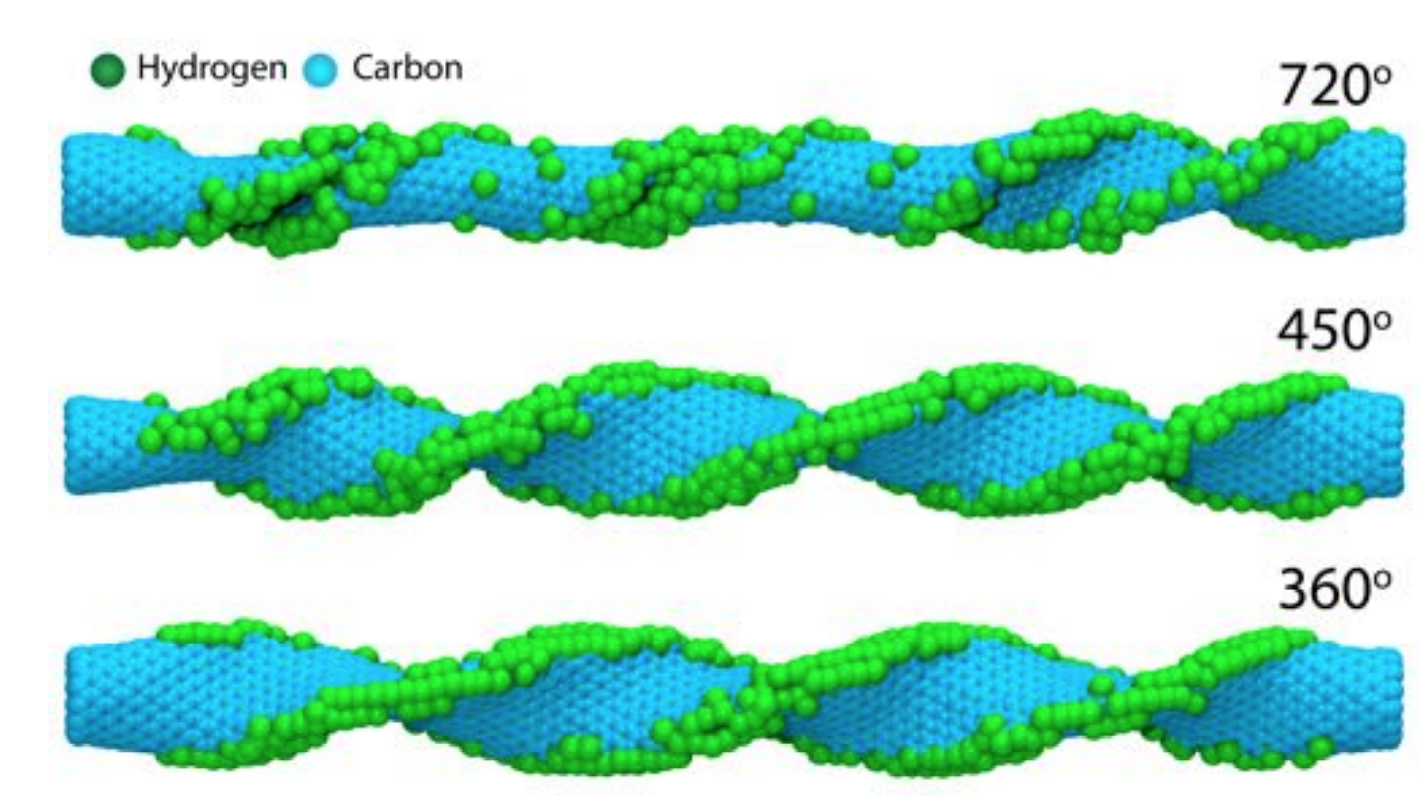
de Sousa, Jose M.; Autreto, Pedro A. S.; Galvao, Douglas S.
Hydrogenation Dynamics of Twisted Carbon Nanotubes Online
2015, (ArXiv preprint).
Abstract | Links | BibTeX | Tags: Carbon Nanotubes, Hydrogenation, Mechanical Properties, Molecular Dynamics
@online{deSousa2015,
title = {Hydrogenation Dynamics of Twisted Carbon Nanotubes},
author = {Jose M. de Sousa and Pedro A. S. Autreto and Douglas S. Galvao},
url = {http://arxiv.org/abs/1510.00265},
year = {2015},
date = {2015-10-01},
abstract = {Carbon Nanotubes (CNTs) are one of the most important materials in nanotechnology. In some of their technological applications (electromechanical oscillators and mechanical actuators for artificial muscles, for instance), it is necessary to subject them to large deformations. Although this frequently happens in air, there are only few studies about the interaction of deformed CNTs with the atmosphere and the dynamics of these processes has not yet been addressed. In this work, we have investigated, through fully atomistic reactive molecular dynamics simulations, the process of hydrogenation of highly twisted CNTs. Our results show that hydrogenation effective ratio is directly related to the tube twist angle values and can lead to twisted tube fractures with well defined patterns (unzip-like). Our results also show that these fracture processes can be exploited to controllably produce graphene nanoribbons.},
note = {ArXiv preprint},
keywords = {Carbon Nanotubes, Hydrogenation, Mechanical Properties, Molecular Dynamics},
pubstate = {published},
tppubtype = {online}
}
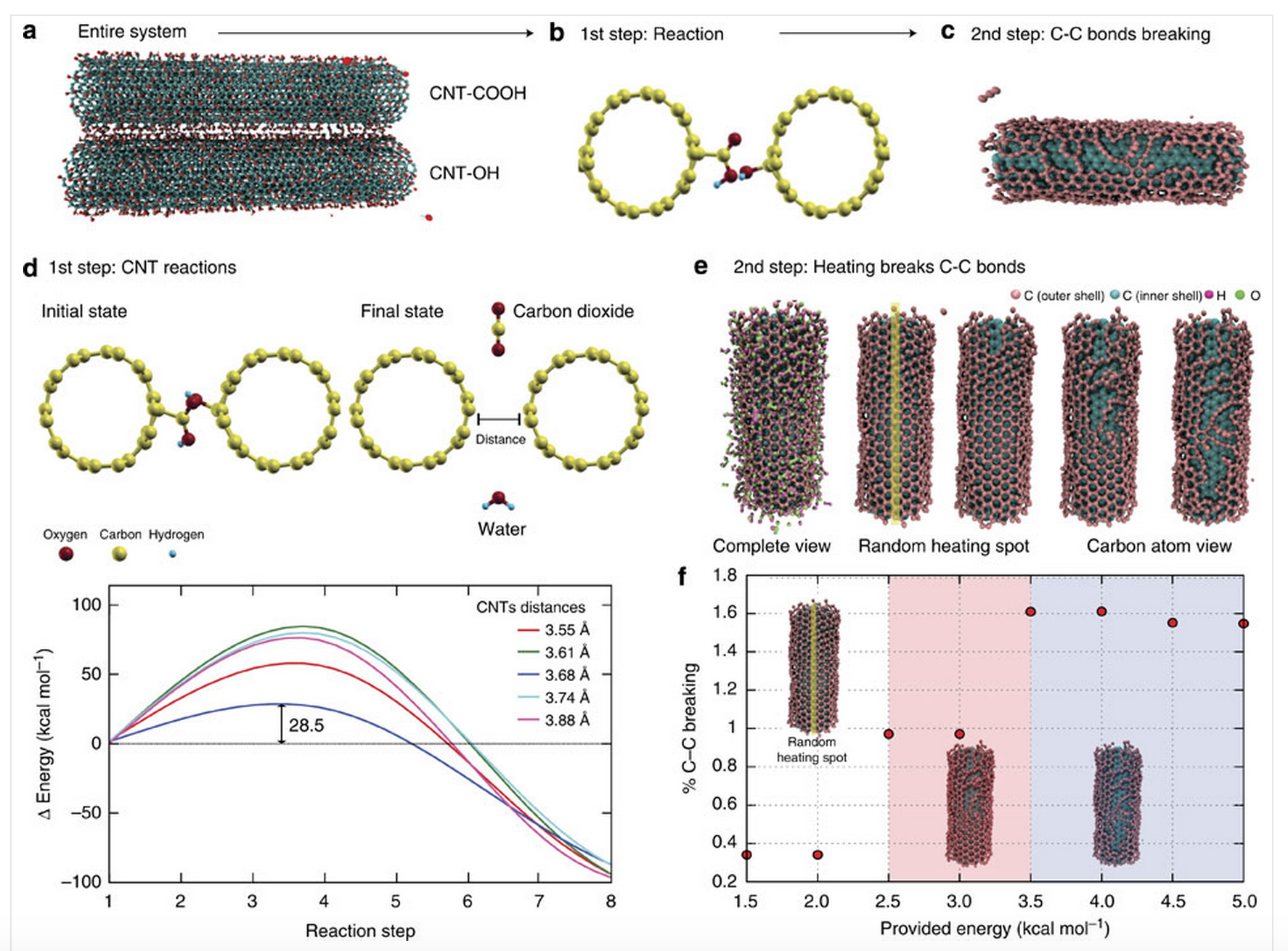
Chandra Sekhar Tiwary Mohamad A Kabbani, Pedro AS Autreto
Ambient solid-state mechano-chemical reactions between functionalized carbon nanotubes Journal Article
In: Nature Communications, vol. 6, pp. 7291, 2015.
Abstract | Links | BibTeX | Tags: Carbon Nanotubes, Chemical Reactions, Electronic Structure, Molecular Dynamics, top20
@article{Kabbani2015,
title = {Ambient solid-state mechano-chemical reactions between functionalized carbon nanotubes},
author = {Mohamad A Kabbani, Chandra Sekhar Tiwary, Pedro AS Autreto, Gustavo Brunetto, Anirban Som, KR Krishnadas, Sehmus Ozden, Ken P Hackenberg, Yongi Gong, Douglas S Galvao, Robert Vajtai, Ahmad T Kabbani, Thalappil Pradeep, Pulickel M Ajayan},
url = {http://www.nature.com/ncomms/2015/150615/ncomms8291/full/ncomms8291.html},
doi = {10.1038/ncomms8291},
year = {2015},
date = {2015-06-15},
journal = {Nature Communications},
volume = {6},
pages = {7291},
abstract = {Carbon nanotubes can be chemically modified by attaching various functionalities to their surfaces, although harsh chemical treatments can lead to their break-up into graphene nanostructures. On the other hand, direct coupling between functionalities bound on individual nanotubes could lead to, as yet unexplored, spontaneous chemical reactions. Here we report an ambient mechano-chemical reaction between two varieties of nanotubes, carrying predominantly carboxyl and hydroxyl functionalities, respectively, facilitated by simple mechanical grinding of the reactants. The purely solid-state reaction between the chemically differentiated nanotube species produces condensation products and unzipping of nanotubes due to local energy release, as confirmed by spectroscopic measurements, thermal analysis and molecular dynamic simulations.},
keywords = {Carbon Nanotubes, Chemical Reactions, Electronic Structure, Molecular Dynamics, top20},
pubstate = {published},
tppubtype = {article}
}
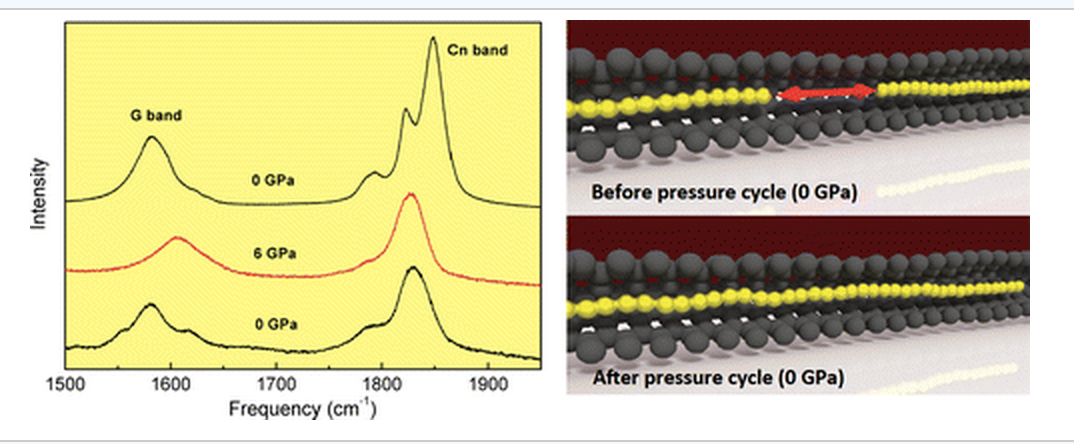
Acrísio L Aguiar Nadia Ferreira Andrade, Yoong Ahm Kim
Linear Carbon Chains Under High Pressure Conditions Journal Article
In: The Journal of Physical Chemistry C, vol. 119, no. 19, pp. 10669–10676, 2015.
Abstract | Links | BibTeX | Tags: Atomic Chains, Carbon Nanotubes, Electronic Structure, Molecular Dynamics, Raman
@article{Andrade2015,
title = {Linear Carbon Chains Under High Pressure Conditions},
author = {Nadia Ferreira Andrade, Acrísio L Aguiar, Yoong Ahm Kim, Morinobu Endo, Paulo TC Freire, Gustavo Bruneto, Douglas Soares Galvao, Mildred S Dresselhaus, Antonio Gomes Souza Filho},
url = {http://pubs.acs.org/doi/abs/10.1021/acs.jpcc.5b00902},
doi = {10.1021/acs.jpcc.5b00902},
year = {2015},
date = {2015-04-23},
journal = {The Journal of Physical Chemistry C},
volume = {119},
number = {19},
pages = {10669–10676},
abstract = {A high-pressure resonance Raman spectroscopy study of linear carbon chains encapsulated inside multiwalled carbon nanotubes (MWCNTs) is reported. While the frequencies of the tangential modes of carbon nanotubes (G band) harden as the pressure increases, the vibrational frequencies of the chain modes (around 1850 cm–1) decrease, thus indicating a softening of the carbon–carbon bonds in this 1D solid. Pressure-induced irreversible structural changes in the linear carbon chains are unveiled by the red shift in the vibrational modes when pressure is released. These results have been interpreted as being due to a coalescence of carbon chains, and this hypothesis is supported by state-of-the-art atomistic reactive molecular dynamics simulations.},
keywords = {Atomic Chains, Carbon Nanotubes, Electronic Structure, Molecular Dynamics, Raman},
pubstate = {published},
tppubtype = {article}
}
2014
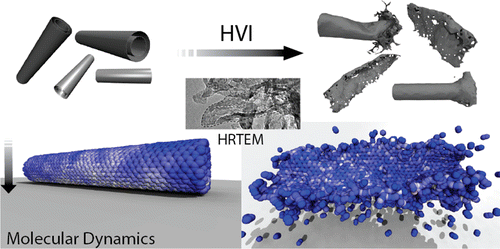
Ozden, Sehmus; Autreto, Pedro AS; Tiwary, Chandra Sekhar; Khatiwada, Suman; Machado, Leonardo; Galvao, Douglas S; Vajtai, Robert; Barrera, Enrique V; M. Ajayan, Pulickel
Unzipping Carbon Nanotubes at High Impact Journal Article
In: Nano letters, vol. 14, no. 7, pp. 4131–4137, 2014.
Abstract | Links | BibTeX | Tags: Carbon Nanotubes, Fracture, Unzipping
@article{ozden2014unzipping,
title = {Unzipping Carbon Nanotubes at High Impact},
author = {Ozden, Sehmus and Autreto, Pedro AS and Tiwary, Chandra Sekhar and Khatiwada, Suman and Machado, Leonardo and Galvao, Douglas S and Vajtai, Robert and Barrera, Enrique V and M. Ajayan, Pulickel},
url = {http://pubs.acs.org/doi/abs/10.1021/nl501753n},
year = {2014},
date = {2014-01-01},
journal = {Nano letters},
volume = {14},
number = {7},
pages = {4131--4137},
publisher = {American Chemical Society},
abstract = {The way nanostructures behave and mechanically respond to high impact collision is a topic of intrigue. For anisotropic nanostructures, such as carbon nanotubes, this response will be complicated based on the impact geometry. Here we report the result of hypervelocity impact of nanotubes against solid targets and show that impact produces a large number of defects in the nanotubes, as well as rapid atom evaporation, leading to their unzipping along the nanotube axis. Fully atomistic reactive molecular dynamics simulations are used to gain further insights of the pathways and deformation and fracture mechanisms of nanotubes under high energy mechanical impact. Carbon nanotubes have been unzipped into graphene nanoribbons before using chemical treatments but here the instability of nanotubes against defect formation, fracture, and unzipping is revealed purely through mechanical impact.},
keywords = {Carbon Nanotubes, Fracture, Unzipping},
pubstate = {published},
tppubtype = {article}
}

Brunetto, Gustavo; Andrade, Nadia F.; Galvao, Douglas S; Antonio Filho, G Souza
High Pressure Induced Binding Between Linear Carbon Chains and Nanotubes Proceedings
2014.
Abstract | Links | BibTeX | Tags: Atomic Chains, Carbon Nanotubes, Molecular Dynamics
@proceedings{brunetto2014high,
title = {High Pressure Induced Binding Between Linear Carbon Chains and Nanotubes},
author = {Brunetto, Gustavo and Andrade, Nadia F. and Galvao, Douglas S and Antonio Filho, G Souza},
url = {http://arxiv.org/abs/1412.7966},
year = {2014},
date = {2014-01-01},
journal = {arXiv preprint arXiv:1412.7966},
abstract = {Recent studies of single-walled carbon nanotubes (CNTs) in aqueous media have showed that water can significantly affect the tube mechanical properties. CNTs under hydrostatic compression can preserve their elastic properties up to large pressure values, while exhibiting exceptional resistance to mechanical loadings. It was experimentally observed that CNTs with encapsulated linear carbon chains (LCCs), when subjected to high hydrostatic pressure values, present irreversible red shifts in some of their vibrational frequencies. In order to address the cause of this phenomenon, we have carried out fully atomistic reactive (ReaxFF) molecular dynamics (MD) simulations for model structures mimicking the experimental conditions. We have considered the cases of finite and infinite (cyclic boundary conditions) CNTs filled with LCCs (LCC inside CNTs) of different lengths (from 9 up to 40 atoms). Our results show that increasing the hydrostatic pressure causes the CNT to be deformed in an inhomogeneous way due to the LCC presence. The LCC-CNT interface regions exhibit convex curvatures, which results in more reactive sites, thus favoring the formation of covalent chemical bonds between the chain and the nanotube. This process is irreversible with the newly formed bonds continuing to exist even after releasing the external pressure and causing an irreversibly red shift in the chain vibrational modes from 1850 to 1500 cm−1.},
keywords = {Atomic Chains, Carbon Nanotubes, Molecular Dynamics},
pubstate = {published},
tppubtype = {proceedings}
}
2013
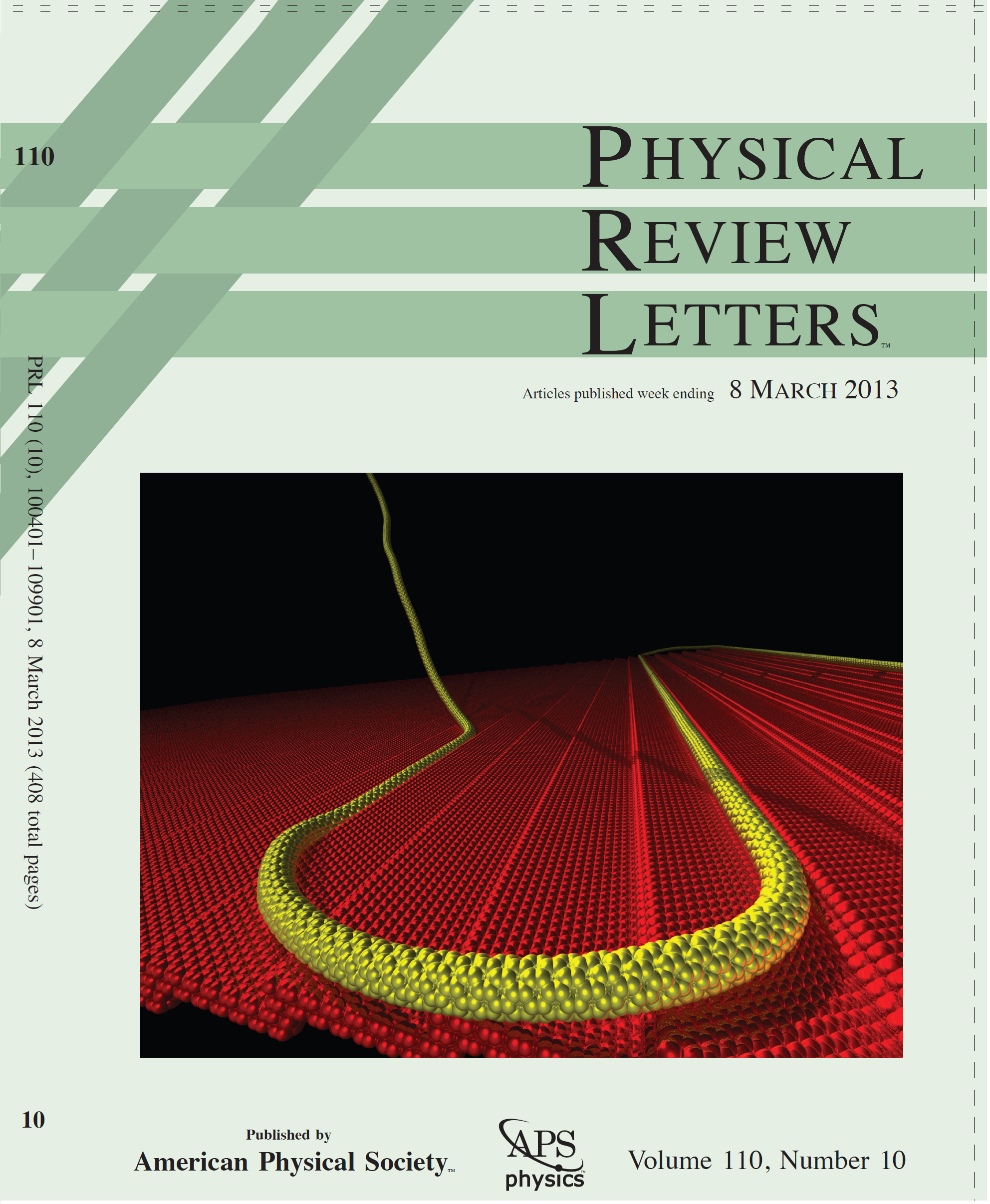
SB Legoas LD Machado, JS Soares
Dynamics of the formation of carbon nanotube serpentines Journal Article
In: Physical Review Letters, vol. 110, no. 10, pp. 105502, 2013.
Abstract | Links | BibTeX | Tags: Carbon Nanotubes, Molecular Dynamics, Serpentines, top20
@article{machado2013dynamics,
title = {Dynamics of the formation of carbon nanotube serpentines},
author = {LD Machado, SB Legoas, JS Soares, N Shadmi, A Jorio, E Joselevich, DS Galvão},
url = {http://journals.aps.org/prl/abstract/10.1103/PhysRevLett.110.105502},
year = {2013},
date = {2013-01-01},
journal = {Physical Review Letters},
volume = {110},
number = {10},
pages = {105502},
publisher = {American Physical Society},
abstract = {Recently, Geblinger et al. [Nat. Nanotechnol. 3, 195 (2008)] reported the experimental realization of carbon nanotube S-like shaped nanostructures, the so-called carbon nanotube serpentines. We report here results from multimillion fully atomistic molecular dynamics simulations of their formation. We consider one-μm-long carbon nanotubes placed on stepped substrates with and without a catalyst nanoparticle on the top free end of the tube. A force is applied to the upper part of the tube during a short period of time and turned off; then the system is set free to evolve in time. Our results show that these conditions are sufficient to form robust serpentines and validates the general features of the “falling spaghetti model” proposed to explain their formation.
},
keywords = {Carbon Nanotubes, Molecular Dynamics, Serpentines, top20},
pubstate = {published},
tppubtype = {article}
}
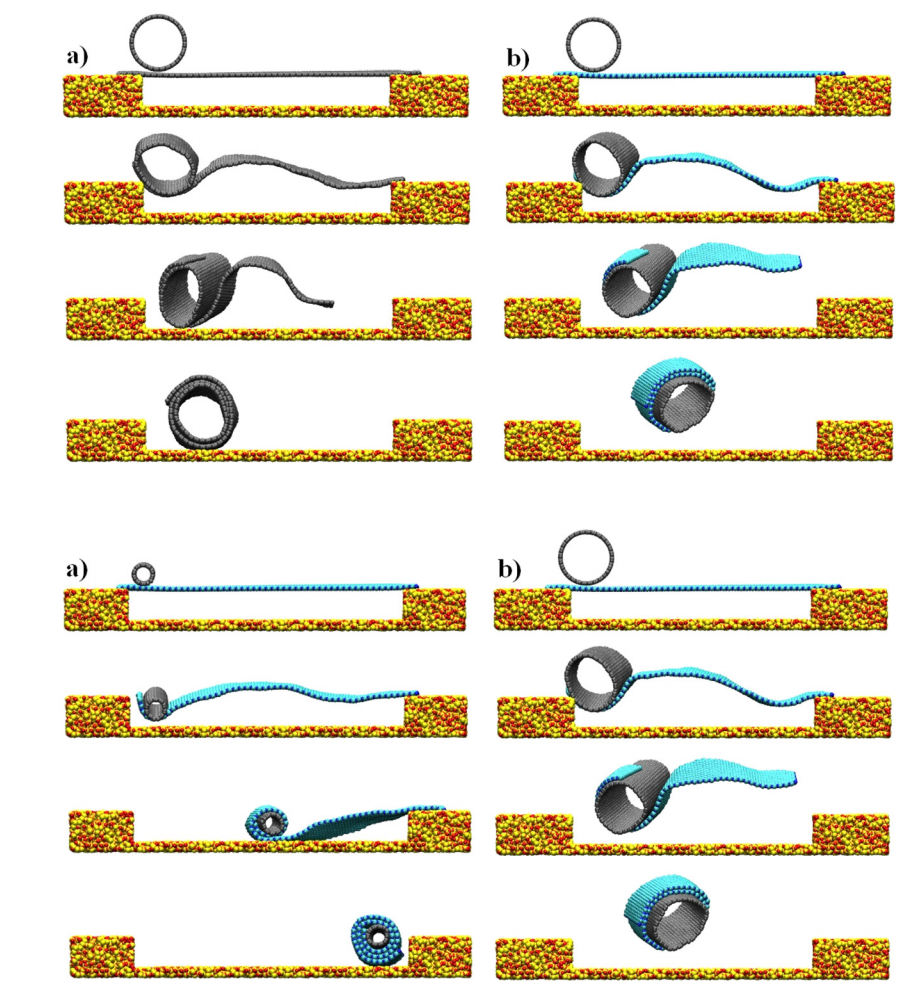
Perim, Eric; Paupitz, Ricardo; Galvao, Douglas S
Controlled route to the fabrication of carbon and boron nitride nanoscrolls: A molecular dynamics investigation Journal Article
In: Journal of Applied Physics, vol. 113, no. 5, pp. 054306, 2013.
Abstract | Links | BibTeX | Tags: Boron Nitride, Carbon Nanotubes, Graphene, Molecular Dynamics, Scrolls
@article{perim2013controlled,
title = {Controlled route to the fabrication of carbon and boron nitride nanoscrolls: A molecular dynamics investigation},
author = {Perim, Eric and Paupitz, Ricardo and Galvao, Douglas S},
url = {http://scitation.aip.org/content/aip/journal/jap/113/5/10.1063/1.4790304},
year = {2013},
date = {2013-01-01},
journal = {Journal of Applied Physics},
volume = {113},
number = {5},
pages = {054306},
publisher = {AIP Publishing},
abstract = {Carbon nanoscrolls (graphene layers rolled up into papyrus-like tubular structures) are nanostructures with unique and interesting characteristics that could be exploited to build several new nanodevices. However, an efficient and controlled synthesis of these structures was not achieved yet, making its large scale production a challenge to materials scientists. Also, the formation process and detailed mechanisms that occur during its synthesis are not completely known. In this work, using fully atomistic molecular dynamics simulations, we discuss a possible route to nanoscrolls made from graphene layers deposited over silicon oxide substrates containing chambers/pits. The scrolling mechanism is triggered by carbon nanotubes deposited on the layers. The process is completely general and can be used to produce scrolls from other lamellar materials, like boron nitride, for instance.},
keywords = {Boron Nitride, Carbon Nanotubes, Graphene, Molecular Dynamics, Scrolls},
pubstate = {published},
tppubtype = {article}
}
2012

Lima, Marcio D; Li, Na; De Andrade, Monica Jung; Fang, Shaoli; Oh, Jiyoung; Spinks, Geoffrey M; Kozlov, Mikhail E; Haines, Carter S; Suh, Dongseok; Foroughi, Javad; Kim, Seon Jeong; Chen, Yongsheng; Ware, Taylor; Shin, Min Kyoon; Machado, Leonardo D; Fonseca, Alexandre F; Madden, John DW; Voit, Walter E; Galvao, Douglas S; Baughman, Ray H
Electrically, chemically, and photonically powered torsional and tensile actuation of hybrid carbon nanotube yarn muscles Journal Article
In: Science, vol. 338, no. 6109, pp. 928–932, 2012.
Abstract | Links | BibTeX | Tags: Actuation, Artificial Muscles, Carbon Nanotubes, top20, Yarns
@article{lima2012electrically,
title = {Electrically, chemically, and photonically powered torsional and tensile actuation of hybrid carbon nanotube yarn muscles},
author = {Lima, Marcio D and Li, Na and De Andrade, Monica Jung and Fang, Shaoli and Oh, Jiyoung and Spinks, Geoffrey M and Kozlov, Mikhail E and Haines, Carter S and Suh, Dongseok and Foroughi, Javad and Kim, Seon Jeong and Chen, Yongsheng and Ware, Taylor and Shin, Min Kyoon and Machado, Leonardo D and Fonseca, Alexandre F and Madden, John DW and Voit, Walter E and Galvao, Douglas S and Baughman, Ray H
},
url = {http://www.sciencemag.org/content/338/6109/928.short},
year = {2012},
date = {2012-01-01},
journal = {Science},
volume = {338},
number = {6109},
pages = {928--932},
publisher = {American Association for the Advancement of Science},
abstract = {Artificial muscles are of practical interest, but few types have been commercially exploited. Typical problems include slow response, low strain and force generation, short cycle life, use of electrolytes, and low energy efficiency. We have designed guest-filled, twist-spun carbon nanotube yarns as electrolyte-free muscles that provide fast, high-force, large-stroke torsional and tensile actuation. More than a million torsional and tensile actuation cycles are demonstrated, wherein a muscle spins a rotor at an average 11,500 revolutions/minute or delivers 3% tensile contraction at 1200 cycles/minute. Electrical, chemical, or photonic excitation of hybrid yarns changes guest dimensions and generates torsional rotation and contraction of the yarn host. Demonstrations include torsional motors, contractile muscles, and sensors that capture the energy of the sensing process to mechanically actuate.},
keywords = {Actuation, Artificial Muscles, Carbon Nanotubes, top20, Yarns},
pubstate = {published},
tppubtype = {article}
}
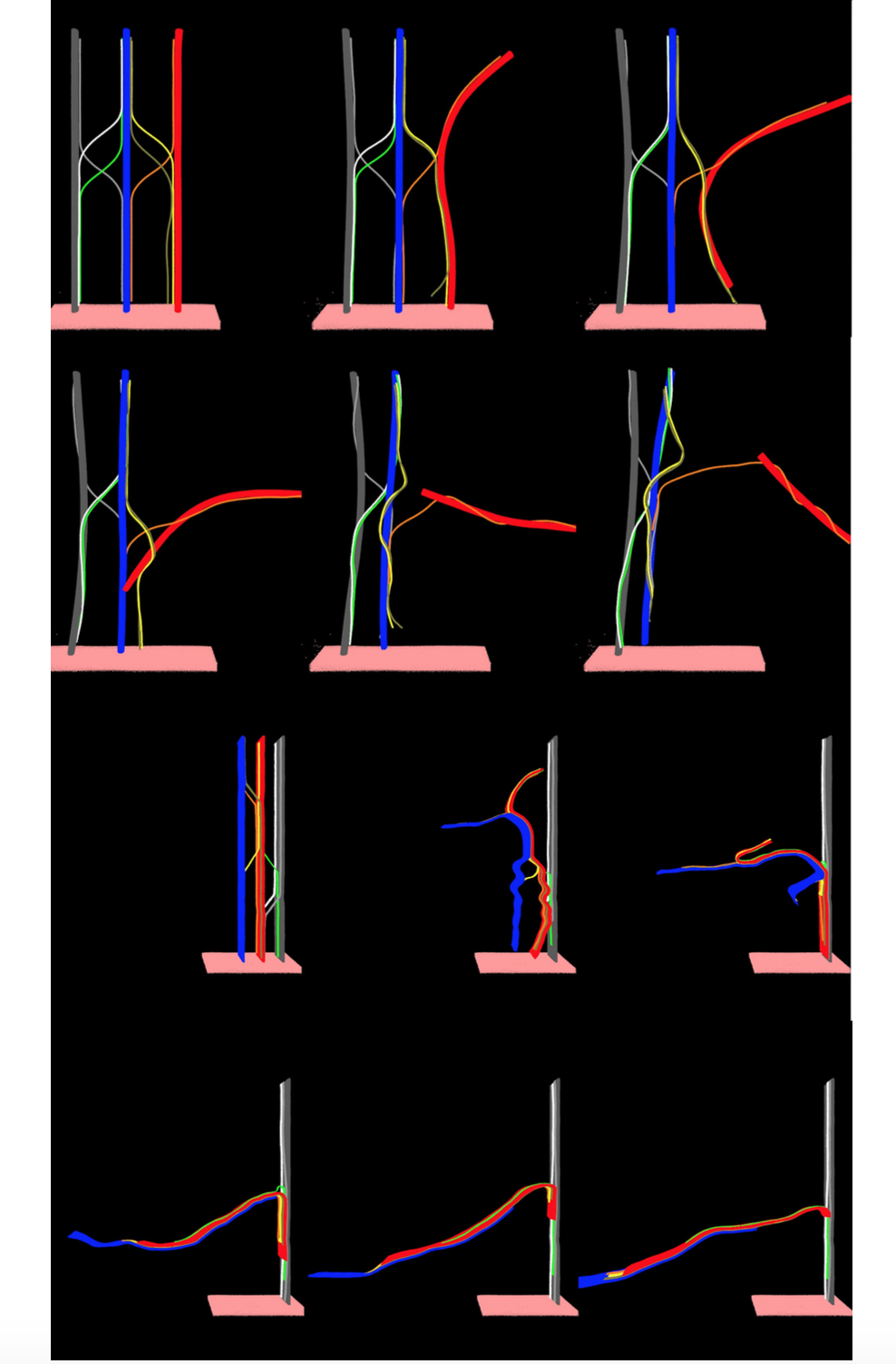
Machado, Leonardo D; Legoas, Sergio B; Galvao, Douglas S
Multi-Million Fully Atomistic Molecular Dynamics Simulations of Yarn Formation from Carbon Nanotube Forests Proceedings
Cambridge University Press, vol. 1407, 2012.
Abstract | Links | BibTeX | Tags: Carbon Nanotube Forests, Carbon Nanotubes, Molecular Dynamics, Yarns
@proceedings{machado2012multi,
title = {Multi-Million Fully Atomistic Molecular Dynamics Simulations of Yarn Formation from Carbon Nanotube Forests},
author = {Machado, Leonardo D and Legoas, Sergio B and Galvao, Douglas S},
url = {http://journals.cambridge.org/action/displayAbstract?fromPage=online&aid=8537115&fulltextType=RA&fileId=S1946427412007105},
year = {2012},
date = {2012-01-01},
journal = {MRS Proceedings},
volume = {1407},
pages = {mrsf11--1407},
publisher = {Cambridge University Press},
abstract = {In this work we present preliminary results from multi-million fully atomistic classical molecular dynamics simulations carried out to test different existing mechanisms that have been proposed in the literature to explain the drawing of yarns from carbon nanotube forests. Despite the fact that it has been almost ten years since yarns were first drawn, there are still controversies on the mechanisms and necessary conditions that can produce yarns and sheets drawn from carbon nanotube forests. Moreover, few works have tried to understand at atomistic level the details of yarn drawing mechanisms, and no fully atomistic simulations have been carried out so far on this particular subject. Our preliminary results suggest that only direct van der Waals interactions among large bundles seem not to be enough to explain the yarn drawing process. Bundle interconnectors (such as small bundles connecting large bundles) were observed to play a critical role in our simulations. Depending on the topology of these interconnectors it was possible to observe from the simulations fibers/yarn formation from proposed structural models. These models were built based on structural information inferred from scanning electron microscopy data.},
keywords = {Carbon Nanotube Forests, Carbon Nanotubes, Molecular Dynamics, Yarns},
pubstate = {published},
tppubtype = {proceedings}
}
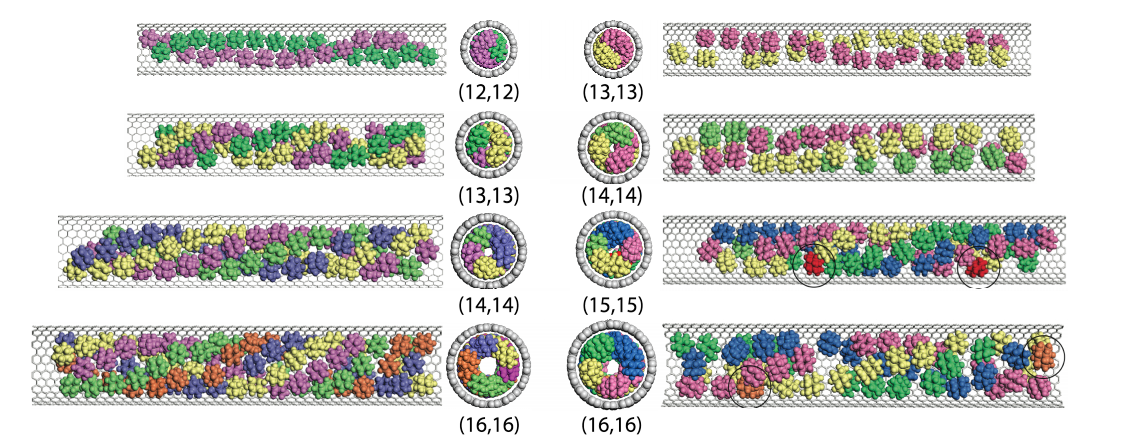
Legoas, SB; dos Santos, RPB; Troche, KS; Coluci, VR; Galvao, Douglas S
On the Existence of Ordered Phases of Encapsulated Diamondoids into Carbon Nanotubes Proceedings
Cambridge University Press, vol. 1407, 2012.
Abstract | Links | BibTeX | Tags: Carbon Nanotubes, Diamondoids, Encapsulation
@proceedings{legoas2012existence,
title = {On the Existence of Ordered Phases of Encapsulated Diamondoids into Carbon Nanotubes},
author = {Legoas, SB and dos Santos, RPB and Troche, KS and Coluci, VR and Galvao, Douglas S},
url = {http://journals.cambridge.org/action/displayAbstract?fromPage=online&aid=8539583&fileId=S194642741200704X},
year = {2012},
date = {2012-01-01},
journal = {MRS Proceedings},
volume = {1407},
pages = {mrsf11--1407},
publisher = {Cambridge University Press},
abstract = {We have investigated some diamondoids encapsulation into single walled carbon nanotubes (with diameters ranging from1.0 up to 2.2 nm) using fully atomistic molecular dynamics simulations. Diamondoids are the smallest hydrogen-terminated nanosized diamond-like molecules. Diamondois have been investigated for a large class of applications, ranging from oil industry to pharmaceuticals. Molecular ordered phases were observed for the encapsulation of adamantane, diamantane, and dihydroxy diamantanes. Chiral ordered phases, such as; double, triple, 4- and 5-stranded helices were also observed for those diamondoids. Our results also indicate that the modification of diamondoids through chemical functionalization with hydroxyl groups can lead to an enhancement of the molecular packing inside the carbon nanotubes in comparison to non-functionalized molecules. For larger diamondoids (such as, adamantane tetramers), we have not observed long-range ordering, but only a tendency of incomplete helical structural formation.},
keywords = {Carbon Nanotubes, Diamondoids, Encapsulation},
pubstate = {published},
tppubtype = {proceedings}
}
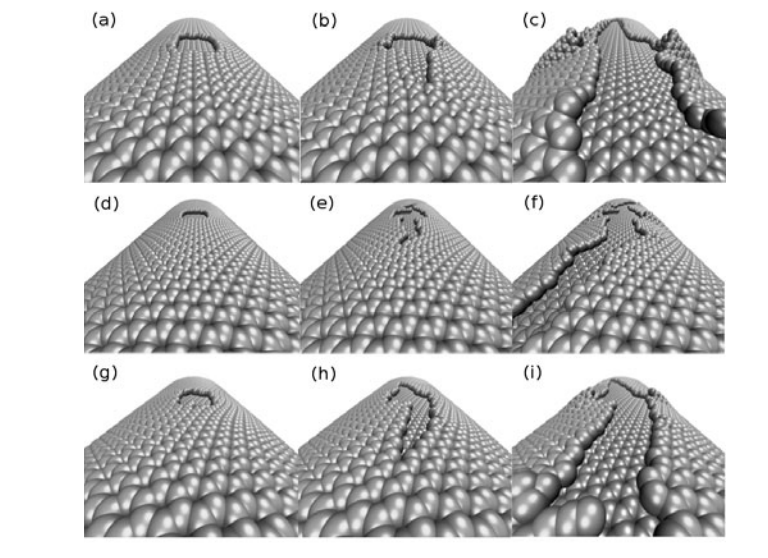
dos Santos, Ricardo P; Autreto, Pedro A; Perim, Eric; Brunetto, Gustavo; Galvao, Douglas S
On the Unzipping Mechanisms of Carbon Nanotubes: Insights from Reactive Molecular Dynamics Simulations Proceedings
Cambridge University Press, vol. 1451, 2012.
Abstract | Links | BibTeX | Tags: Carbon Nanotubes, Molecular Dynamics, Unzipping
@proceedings{dos2012unzipping,
title = {On the Unzipping Mechanisms of Carbon Nanotubes: Insights from Reactive Molecular Dynamics Simulations},
author = {dos Santos, Ricardo P and Autreto, Pedro A and Perim, Eric and Brunetto, Gustavo and Galvao, Douglas S},
url = {http://journals.cambridge.org/action/displayAbstract?fromPage=online&aid=8652294&fileId=S1946427412013292},
year = {2012},
date = {2012-01-01},
journal = {MRS Proceedings},
volume = {1451},
pages = {3--8},
publisher = {Cambridge University Press},
abstract = {Unzipping carbon nanotubes (CNTs) is considered one of the most promising approaches for the controlled and large-scale production of graphene nanoribbons (GNR). These structures are considered of great importance for the development of nanoelectronics because of its dimensions and intrinsic nonzero band gap value. Despite many years of investigations some details on the dynamics of the CNT fracture/unzipping processes remain unclear. In this work we have investigated some of these process through molecular dynamics simulations using reactive force fields (ReaxFF), as implemented in the Large-scale Atomic/Molecular Massively Parallel Simulator (LAMMPS) code. We considered multi-walled CNTs of different dimensions and chiralities and under induced mechanical stretching. Our preliminary results show that the unzipping mechanisms are highly dependent on CNT chirality. Well-defined and distinct fracture patterns were observed for the different chiralities. Armchair CNTs favor the creation of GNRs with well-defined armchair edges, while zigzag and chiral ones produce GNRs with less defined and defective edges.},
keywords = {Carbon Nanotubes, Molecular Dynamics, Unzipping},
pubstate = {published},
tppubtype = {proceedings}
}
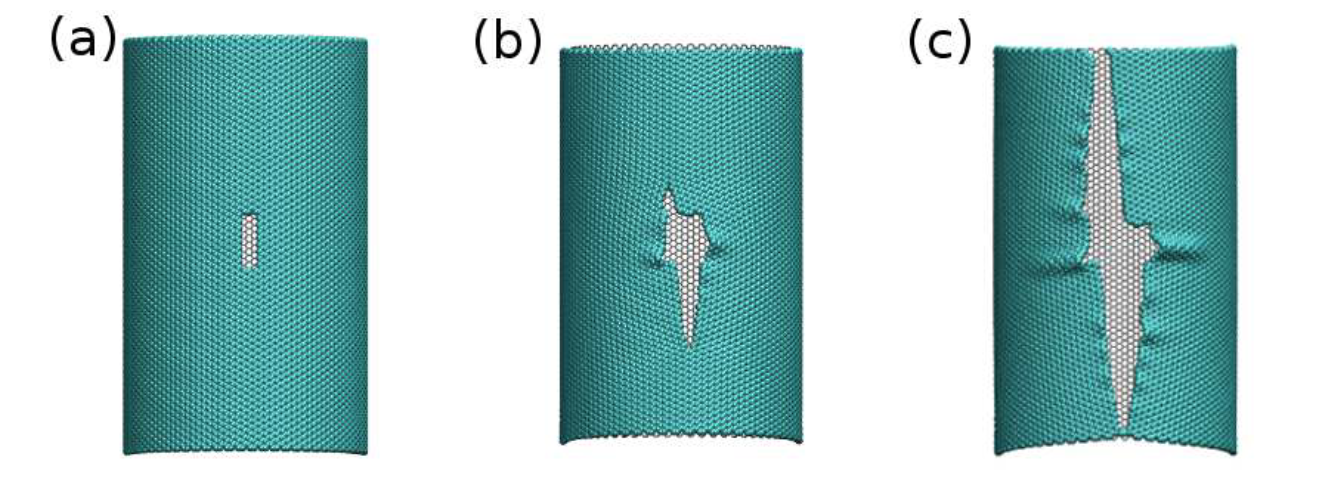
Dos Santos, RPB; Perim, E; Autreto, PAS; Brunetto, Gustavo; Galvao, DS
On the unzipping of multiwalled carbon nanotubes Journal Article
In: Nanotechnology, vol. 23, no. 46, pp. 465702, 2012.
Abstract | Links | BibTeX | Tags: Carbon Nanotubes, Fracture, Molecular Dynamics, Unzipping
@article{dos2012unzippingb,
title = {On the unzipping of multiwalled carbon nanotubes},
author = {Dos Santos, RPB and Perim, E and Autreto, PAS and Brunetto, Gustavo and Galvao, DS},
url = {http://iopscience.iop.org/0957-4484/23/46/465702},
year = {2012},
date = {2012-01-01},
journal = {Nanotechnology},
volume = {23},
number = {46},
pages = {465702},
publisher = {IOP Publishing},
abstract = {Graphene nanoribbons (GNRs) are very interesting structures which can retain graphene's high carrier mobility while presenting a finite bandgap. These properties make GNRs very valuable materials for the building of nanodevices. Unzipping carbon nanotubes (CNTs) is considered one of the most promising approaches for GNR controlled and large-scale production, although some of the details of the CNT unzipping processes are not completely known. In this work we have investigated CNT unzipping processes through fully atomistic molecular dynamics simulations using reactive force fields (ReaxFF). Multiwalled CNTs of different dimensions and chiralities under induced mechanical stretching were considered. Our results show that fracture patterns and stress profiles are highly CNT chirality dependent. Our results also show that the 'crests' (partially unzipped CNT regions presenting high curvature), originating from defective CNT areas, can act as a guide for the unzipping processes, which can explain the almost perfectly linear cuts frequently observed in unzipped CNTs.
},
keywords = {Carbon Nanotubes, Fracture, Molecular Dynamics, Unzipping},
pubstate = {published},
tppubtype = {article}
}
2010
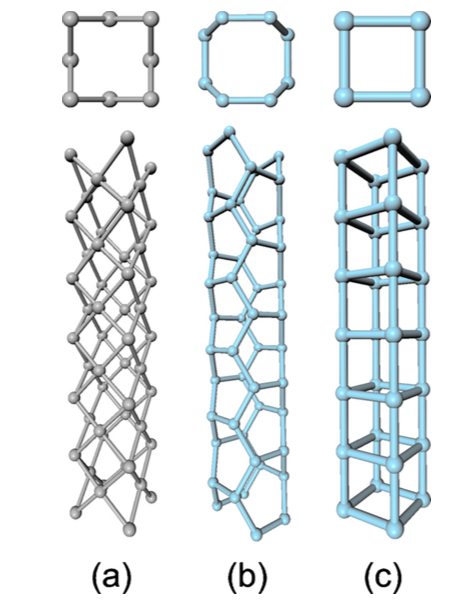
Autreto, PAS; Legoas, SB; Flores, MZS; Galvao, DS
Carbon nanotube with square cross-section: An ab initio investigation Journal Article
In: The Journal of chemical physics, vol. 133, no. 12, pp. 124513, 2010.
Abstract | Links | BibTeX | Tags: Carbon Nanotubes, DFT, New Structures, square tubes
@article{autreto2010carbon,
title = {Carbon nanotube with square cross-section: An ab initio investigation},
author = {Autreto, PAS and Legoas, SB and Flores, MZS and Galvao, DS},
url = {http://scitation.aip.org/content/aip/journal/jcp/133/12/10.1063/1.3483237},
year = {2010},
date = {2010-01-01},
journal = {The Journal of chemical physics},
volume = {133},
number = {12},
pages = {124513},
publisher = {AIP Publishing},
abstract = {Recently, Lagos et al. [Nat. Nanotechnol.4, 149 (2009)] reported the discovery of the smallest possible silver square cross-section nanotube. A natural question is whether similar carbon nanotubes can exist. In this work we report ab initio results for the structural, stability, and electronic properties for such hypothetical structures. Our results show that stable (or at least metastable) structures are possible with metallic properties. They also show that these structures can be obtained by a direct interconversion from SWNT(2,2). Large finite cubanelike oligomers, topologically related to these new tubes, were also investigated.
},
keywords = {Carbon Nanotubes, DFT, New Structures, square tubes},
pubstate = {published},
tppubtype = {article}
}
2009
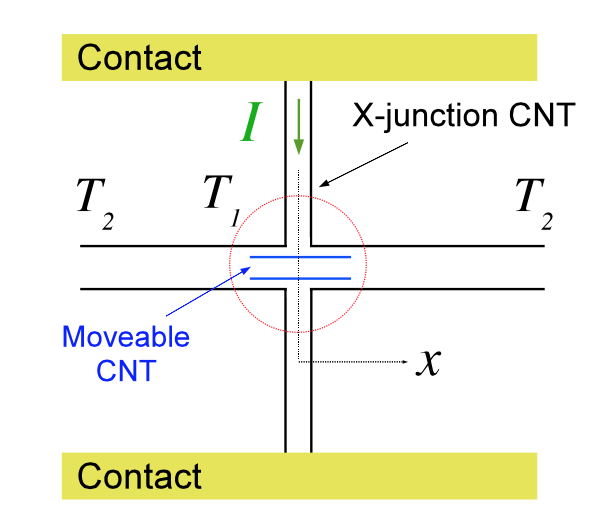
Coluci, VR; Timoteo, VS; Galvao, DS
Thermophoretically driven carbon nanotube oscillators Journal Article
In: Applied Physics Letters, vol. 95, no. 25, pp. 253103, 2009.
Abstract | Links | BibTeX | Tags: Carbon Nanotubes, Chaos, Oscillators, Thermophoretical
@article{coluci2009thermophoretically,
title = {Thermophoretically driven carbon nanotube oscillators},
author = {Coluci, VR and Timoteo, VS and Galvao, DS},
url = {http://scitation.aip.org/content/aip/journal/apl/95/25/10.1063/1.3276546},
year = {2009},
date = {2009-01-01},
journal = {Applied Physics Letters},
volume = {95},
number = {25},
pages = {253103},
publisher = {AIP Publishing},
abstract = {The behavior of a nanodevice based upon double-walled carbon nanotubeoscillators driven by periodically applied thermal gradients (7 and 17 K/nm) is investigated by numerical calculations and classical molecular dynamics simulations. Our results indicate that thermophoresis can be effective to initiate the oscillator and that suitable heat pulses may provide an appropriate way to tune its behavior. Sustained regular oscillatory as well as chaotic motions were observed for the systems investigated in this work.},
keywords = {Carbon Nanotubes, Chaos, Oscillators, Thermophoretical},
pubstate = {published},
tppubtype = {article}
}
2008
Nakabayashi, D; Ugarte, D; Moreau, ALD; Coluci, VR; Galvao, DS; Cotta, MA
Carbon nanotubes as R-bars of high aspect ratio composite nanotools Technical Report
2008.
Abstract | Links | BibTeX | Tags: AFM tips, Carbon Nanotubes, Nanocomposites, Tribology
@techreport{nakabayashi2008carbonb,
title = {Carbon nanotubes as R-bars of high aspect ratio composite nanotools},
author = {Nakabayashi, D and Ugarte, D and Moreau, ALD and Coluci, VR and Galvao, DS and Cotta, MA},
url = {http://lnls.cnpem.br/ar2008/},
year = {2008},
date = {2008-01-01},
abstract = {Nano technology requires the development of nano scale tools to manipulate nano systems. From the point of view of materials science, this represents a serious challenge, because nano tools must meet a series of stringent requirements of shape (size, aspect ratio), mechanical, magnetic and electrical properties. We have developed long and narrow carbon-carbon composite nano tips using carbon nanotubes covered by an amorphous carbon shell; the very small nano tube tip remained uncoated to preserve apex size. This configuration renders the system stiffer and allows for the control of flexibility and vibrations. In addition, we have maintained the important nano tube properties of size, strength and resilience. Nano manipulation experiments in situ in a high resolution scanning electron microscope were used to optimize the tips behavior and molecular dynamics simulations were used to study the mechanical response. Finally, we performed a practical application in atomic force microscopy. Composite tips yielded excellent image resolution and showed remarkable wear resistance (no degradation of image quality after acquiring several hundred images). },
keywords = {AFM tips, Carbon Nanotubes, Nanocomposites, Tribology},
pubstate = {published},
tppubtype = {techreport}
}
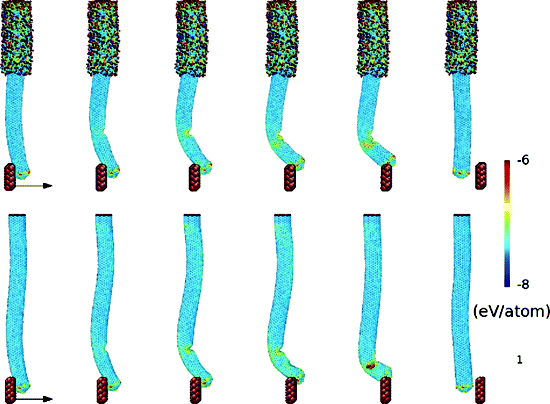
Nakabayashi, D; Moreau, ALD; Coluci, VR; Galvao, DS; Cotta, MA; Ugarte, D
Carbon nanotubes as reinforcement elements of composite nanotools Journal Article
In: Nano letters, vol. 8, no. 3, pp. 842–847, 2008.
Abstract | Links | BibTeX | Tags: AFM tips, Carbon Nanotubes, Molecular Dynamics, Nanocomposites, Tribology
@article{nakabayashi2008carbon,
title = {Carbon nanotubes as reinforcement elements of composite nanotools},
author = {Nakabayashi, D and Moreau, ALD and Coluci, VR and Galvao, DS and Cotta, MA and Ugarte, D},
url = {http://pubs.acs.org/doi/abs/10.1021/nl0729633},
year = {2008},
date = {2008-01-01},
journal = {Nano letters},
volume = {8},
number = {3},
pages = {842--847},
publisher = {American Chemical Society},
abstract = {Nanotechnology is stimulating the development of nanomanipulators, including tips to interact with individual nanosystems. Fabricating nanotips fulfilling the requirements of shape (size, aspect ratio), mechanical, magnetic, and electrical properties is a material science challenge. Here, we report the generation of reinforced carbon−carbon composite nanotools using a nanotube (CNTs) covered by an amorphous carbon matrix (shell); the CNT tip protruded and remained uncoated to preserve apex size. Unsuitable properties such as flexibility and vibration could be controlled without deteriorating the CNT size, strength, and resilience. Nanomanipulation experiments and molecular dynamics simulations have been used to study the mechanical response of these composite beams under bending efforts. AFM probes based on these C−C composite high aspect ratio tips generated excellent image resolution and showed no degradation after acquiring several hundred (400) images.},
keywords = {AFM tips, Carbon Nanotubes, Molecular Dynamics, Nanocomposites, Tribology},
pubstate = {published},
tppubtype = {article}
}
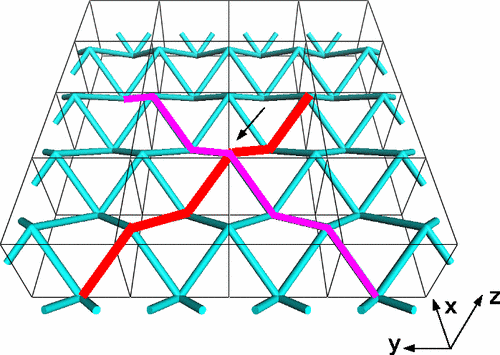
Coluci, Vitor R; Hall, Lee J; Kozlov, Mikhail E; Zhang, Mei; Dantas, Socrates O; Galvao, Douglas S; Baughman, Ray H
Modeling the auxetic transition for carbon nanotube sheets Journal Article
In: Physical Review B, vol. 78, no. 11, pp. 115408, 2008.
Abstract | Links | BibTeX | Tags: Auxetics, Carbon Nanotube Forests, Carbon Nanotubes, CNT sheets
@article{coluci2008modeling,
title = {Modeling the auxetic transition for carbon nanotube sheets},
author = {Coluci, Vitor R and Hall, Lee J and Kozlov, Mikhail E and Zhang, Mei and Dantas, Socrates O and Galvao, Douglas S and Baughman, Ray H},
url = {http://journals.aps.org/prb/abstract/10.1103/PhysRevB.78.115408},
year = {2008},
date = {2008-01-01},
journal = {Physical Review B},
volume = {78},
number = {11},
pages = {115408},
publisher = {APS},
abstract = {A simple model is developed to predict the complex mechanical properties of carbon nanotube sheets (buckypaper) [L. J. Hall et al., Science 320, 504 (2008)]. Fabricated using a similar method to that deployed for making writing paper, these buckypapers can have in-plane Poisson’s ratios changed from positive to negative, becoming auxetic, as multiwalled carbon nanotubes are increasingly mixed with single-walled carbon nanotubes. Essential structural features of the buckypapers are incorporated into the model: isotropic in-plane mechanical properties, nanotubes preferentially oriented in the sheet plane, and freedom to undergo stress-induced elongation by both angle and length changes. The expressions derived for the Poisson’s ratios enabled quantitative prediction of both observed properties and remarkable new properties obtainable by structural modification.},
keywords = {Auxetics, Carbon Nanotube Forests, Carbon Nanotubes, CNT sheets},
pubstate = {published},
tppubtype = {article}
}
2007
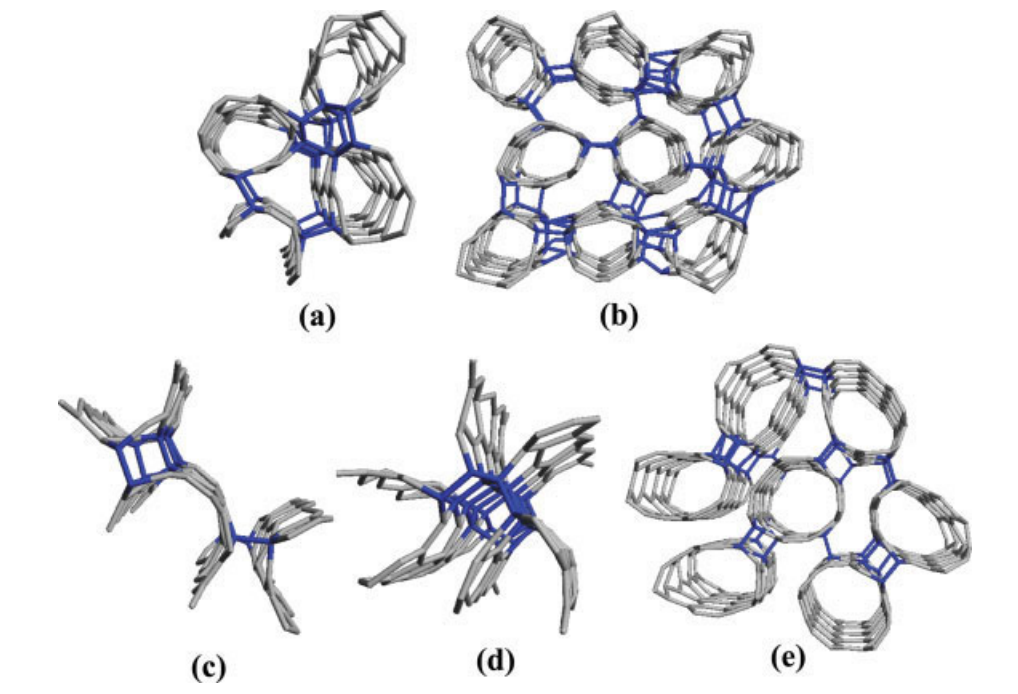
Braga, Scheila Furtado; Galvao, Douglas Soares
Molecular dynamics simulation of single wall carbon nanotubes polymerization under compression Journal Article
In: Journal of Computational Chemistry, vol. 28, no. 10, pp. 1724–1734, 2007.
Abstract | Links | BibTeX | Tags: Carbon Nanotubes, Mechanical Properties, Molecular Dynamics, New Structures, Polymerization
@article{braga2007molecular,
title = {Molecular dynamics simulation of single wall carbon nanotubes polymerization under compression},
author = {Braga, Scheila Furtado and Galvao, Douglas Soares},
url = {http://onlinelibrary.wiley.com/store/10.1002/jcc.20684/asset/20684_ftp.pdf?v=1&t=i52l5iyb&s=94cda082eed01cd61890fffe50aad5e26cdda7d1},
year = {2007},
date = {2007-01-01},
journal = {Journal of Computational Chemistry},
volume = {28},
number = {10},
pages = {1724--1734},
publisher = {Wiley Subscription Services, Inc., A Wiley Company},
abstract = {Single wall carbon nanotubes (SWCNTs) often aggregate into bundles of hundreds of weakly interacting
tubes. Their cross-polymerization opens new possibilities for the creation of new super-hard materials. New mechanical
and electronic properties are expected from these condensed structures, as well as novel potential applications. Previous
theoretical results presented geometric modifications involving changes in the radial section of the compressed tubes
as the explanation to the experimental measurements of structural changes during tube compression. We report here
results from molecular dynamics simulations of the SWCNTs polymerization for small diameter arm chair tubes under
compression. Hydrostatic and piston-type compression of SWCNTs have been simulated for different temperatures and
rates of compression. Our results indicate that large diameter tubes (10,10) are unlike to polymerize while small diameter
ones (around 5 Å) polymerize even at room temperature. Other interesting results are the observation of the appearance
of spontaneous scroll-like structures and also the so-called tubulane motifs, which were predicted in the literature more
than a decade ago},
keywords = {Carbon Nanotubes, Mechanical Properties, Molecular Dynamics, New Structures, Polymerization},
pubstate = {published},
tppubtype = {article}
}
tubes. Their cross-polymerization opens new possibilities for the creation of new super-hard materials. New mechanical
and electronic properties are expected from these condensed structures, as well as novel potential applications. Previous
theoretical results presented geometric modifications involving changes in the radial section of the compressed tubes
as the explanation to the experimental measurements of structural changes during tube compression. We report here
results from molecular dynamics simulations of the SWCNTs polymerization for small diameter arm chair tubes under
compression. Hydrostatic and piston-type compression of SWCNTs have been simulated for different temperatures and
rates of compression. Our results indicate that large diameter tubes (10,10) are unlike to polymerize while small diameter
ones (around 5 Å) polymerize even at room temperature. Other interesting results are the observation of the appearance
of spontaneous scroll-like structures and also the so-called tubulane motifs, which were predicted in the literature more
than a decade ago
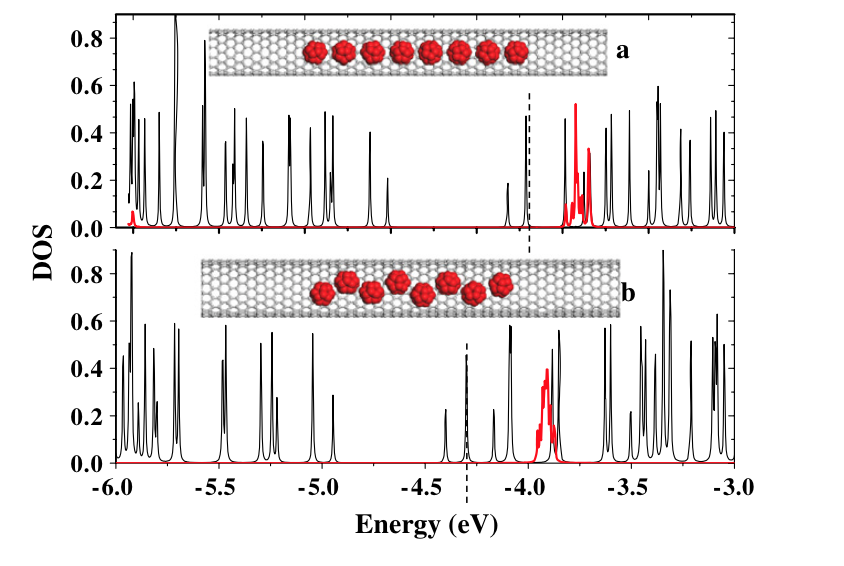
Troche, KS; Coluci, VR; Rurali, R; Galvao, DS
Structural and electronic properties of zigzag carbon nanotubes filled with small fullerenes Journal Article
In: Journal of Physics: Condensed Matter, vol. 19, no. 23, pp. 236222, 2007.
Abstract | Links | BibTeX | Tags: Carbon Nanotubes, CNT encapsulation, Electronic Structure, Fullerenes, Peapods
@article{troche2007structural,
title = {Structural and electronic properties of zigzag carbon nanotubes filled with small fullerenes},
author = {Troche, KS and Coluci, VR and Rurali, R and Galvao, DS},
url = {http://iopscience.iop.org/0953-8984/19/23/236222},
year = {2007},
date = {2007-01-01},
journal = {Journal of Physics: Condensed Matter},
volume = {19},
number = {23},
pages = {236222},
publisher = {IOP Publishing},
abstract = {In this work we investigated the encapsulation of C20 and C30 fullerenes into semiconducting carbon nanotubes to study the possibility of bandgap engineering in such systems. Classical molecular dynamics simulations coupled to tight-binding calculations were used to determine the conformational and electronic properties of carbon nanotubes with an increasing fullerene concentration. We have observed that C20 fullerenes behave similarly to a n-type dopant while C30 can provide p-type doping in some cases. The combined incorporation of both types of fullerenes (hybrid encapsulation) into the same nanotube leads to a behaviour similar to that found in electronic pn-junctions. These aspects can be exploited in the design of nanoelectronic devices using semiconducting carbon nanotubes.
},
keywords = {Carbon Nanotubes, CNT encapsulation, Electronic Structure, Fullerenes, Peapods},
pubstate = {published},
tppubtype = {article}
}
2006
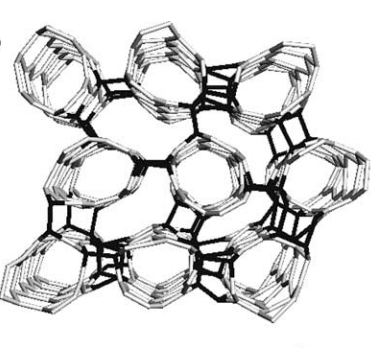
Braga, SF; Galvao, DS
Single wall carbon nanotubes polymerization under compression: An atomistic molecular dynamics study Journal Article
In: Chemical physics letters, vol. 419, no. 4, pp. 394–399, 2006.
Abstract | Links | BibTeX | Tags: Carbon Nanotubes, Molecular Dynamics, Polymerization
@article{braga2006single,
title = {Single wall carbon nanotubes polymerization under compression: An atomistic molecular dynamics study},
author = {Braga, SF and Galvao, DS},
url = {http://www.sciencedirect.com/science/article/pii/S0009261405018592},
year = {2006},
date = {2006-01-01},
journal = {Chemical physics letters},
volume = {419},
number = {4},
pages = {394--399},
publisher = {Elsevier},
abstract = {Recently, it was reported experimental observations of crosslinking between carbon nanotubes (CNTs) under pressure. Similarly to CNT growth formation the details of these polymerization processes are still unclear. In this work, we report a molecular dynamics simulation of the polymerization of a bundle of single-wall carbon nanotubes under compression using Brenner reactive potentials. Our results show that for small tube diameters extensive crosslinking formation can occur. For larger tube diameter, we obtained the first theoretical evidences that scroll-like structures (recently experimentally obtained) can be formed from SWCNTs.
},
keywords = {Carbon Nanotubes, Molecular Dynamics, Polymerization},
pubstate = {published},
tppubtype = {article}
}
2005
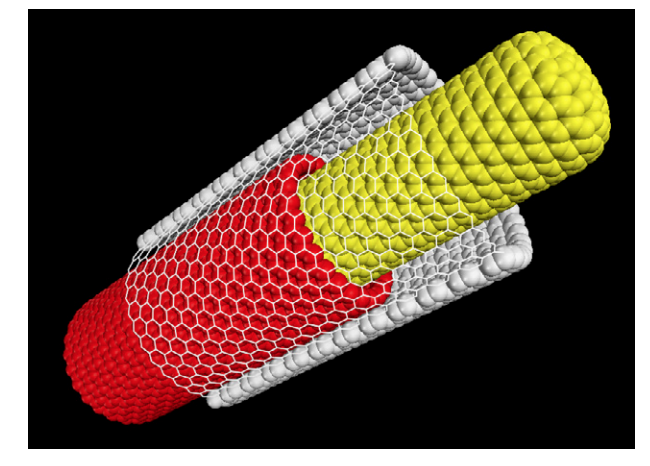
Coluci, VR; Legoas, SB; de Aguiar, MAM; Galvao, DS
Chaotic signature in the motion of coupled carbon nanotube oscillators Journal Article
In: Nanotechnology, vol. 16, no. 4, pp. 583, 2005.
Abstract | Links | BibTeX | Tags: Carbon Nanotubes, Chaos, Oscillators
@article{coluci2005chaotic,
title = {Chaotic signature in the motion of coupled carbon nanotube oscillators},
author = {Coluci, VR and Legoas, SB and de Aguiar, MAM and Galvao, DS},
url = {http://iopscience.iop.org/0957-4484/16/4/041},
year = {2005},
date = {2005-01-01},
journal = {Nanotechnology},
volume = {16},
number = {4},
pages = {583},
publisher = {IOP Publishing},
abstract = {The motion of coupled oscillators based on multiwalled carbon nanotubes is studied using rigid-body dynamics simulations. The results show the existence of chaotic and regular behaviours for a given total energy, indicating the manifestation of chaos in nanoscaled mechanical systems based on carbon nanotube oscillators. Different regular motions are observed for different total energies, and they can be obtained by appropriately choosing the initial conditions. This possibility can allow the construction of multi-functional nano-devices based on multiwalled carbon nanotube oscillators.},
keywords = {Carbon Nanotubes, Chaos, Oscillators},
pubstate = {published},
tppubtype = {article}
}
2004
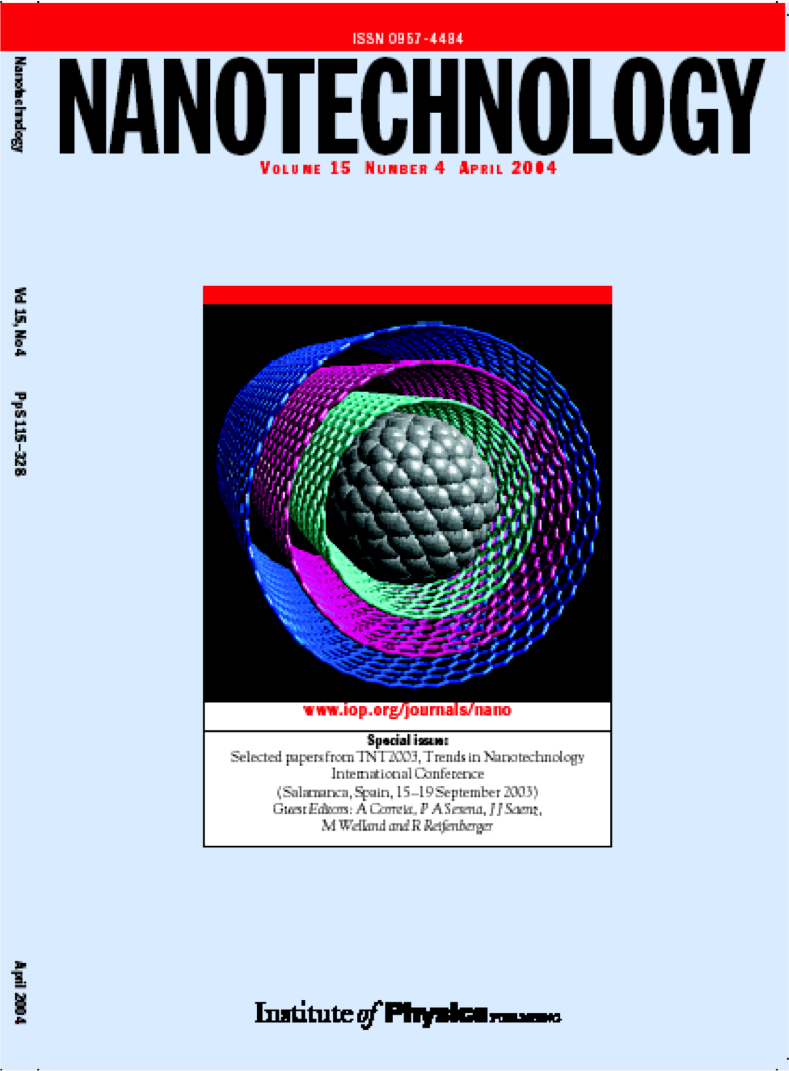
Legoas, SB; Coluci, VR; Braga, SF; Coura, PZ; Dantas, SO; Galvao, DS
Gigahertz nanomechanical oscillators based on carbon nanotubes Journal Article
In: Nanotechnology, vol. 15, no. 4, pp. S184, 2004.
Abstract | Links | BibTeX | Tags: Carbon Nanotubes, Molecular Dynamics, Oscillators
@article{legoas2004gigahertz,
title = {Gigahertz nanomechanical oscillators based on carbon nanotubes},
author = {Legoas, SB and Coluci, VR and Braga, SF and Coura, PZ and Dantas, SO and Galvao, DS},
url = {http://iopscience.iop.org/0957-4484/15/4/012},
year = {2004},
date = {2004-01-01},
journal = {Nanotechnology},
volume = {15},
number = {4},
pages = {S184},
publisher = {IOP Publishing},
abstract = {We report molecular dynamics studies of carbon nanotubes as mechanical gigahertz oscillators. Our results show that different oscillatory regimes exist but that sustained oscillations are possible only when the radii difference values of the inner and outer tubes are {sim }3.4~AA . Frequencies as large as 87 GHz were obtained. Calculated force and frequency values are in good agreement with estimated data from recent experimental investigations.},
keywords = {Carbon Nanotubes, Molecular Dynamics, Oscillators},
pubstate = {published},
tppubtype = {article}
}
2003
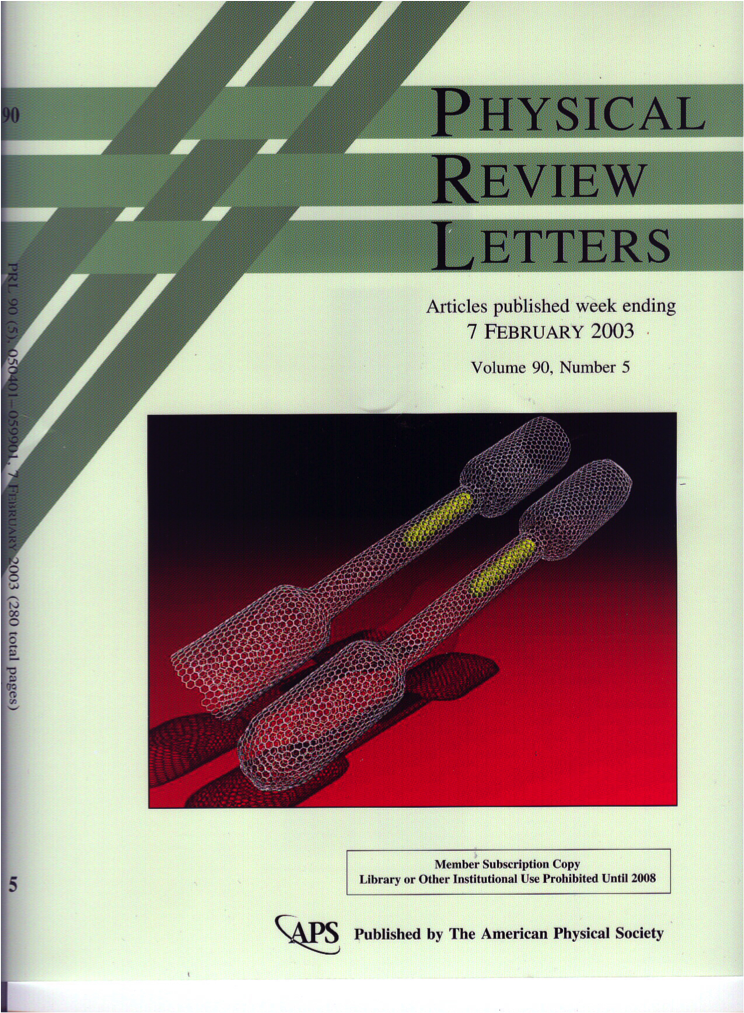
VR Coluci SB Legoas, SF Braga
Molecular-dynamics simulations of carbon nanotubes as gigahertz oscillators Journal Article
In: Physical Review Letters, vol. 90, no. 5, pp. 055504, 2003.
Abstract | BibTeX | Tags: Carbon Nanotubes, Molecular Dynamics, Oscillators, top20
@article{legoas2003molecularb,
title = {Molecular-dynamics simulations of carbon nanotubes as gigahertz oscillators},
author = {SB Legoas, VR Coluci, SF Braga, PZ Coura, SO Dantas, DS Galvao},
year = {2003},
date = {2003-01-01},
journal = {Physical Review Letters},
volume = {90},
number = {5},
pages = {055504},
abstract = {Recently, Zheng and Jiang [Phys. Rev. Lett. 88, 045503 (2002)] have proposed that multiwalled carbon nanotubes could be the basis for a new generation of nano-oscillators in the several gigahertz range. In this Letter, we present the first molecular dynamics simulation for these systems. Different nanotube types were considered in order to verify the reliability of such devices as gigahertz oscillators. Our results show that these nano-oscillators are dynamically stable when the radii difference values between inner and outer tubes are of ∼3.4 Å. Frequencies as large as 38 GHz were observed, and the calculated force values are in good agreement with recent experimental investigations.},
keywords = {Carbon Nanotubes, Molecular Dynamics, Oscillators, top20},
pubstate = {published},
tppubtype = {article}
}
http://scholar.google.com/citations?hl=en&user=95SvbM8AAAAJ


